Physical Address
304 North Cardinal St.
Dorchester Center, MA 02124
Hemorrhoids are specialized vascular cushions in the anal canal or at the anal verge. These cushions are composed of blood vessels, connective tissue, and smooth muscle fibers. Hemorrhoids are a normal part of human anatomy and are responsible for 15% to 20% of anal resting pressure. Hemorrhoids are typically paired and located in the right posterior, right anterior, and left lateral locations. Internal hemorrhoids are positioned cephalad to the dentate line and are covered with mucosa, and external hemorrhoids are located caudal to the dentate line and are covered with anoderm, and most distally, skin. ( Fig. 1 ). Internal hemorrhoids are classified based on their degree of prolapse ( Table 1 ).
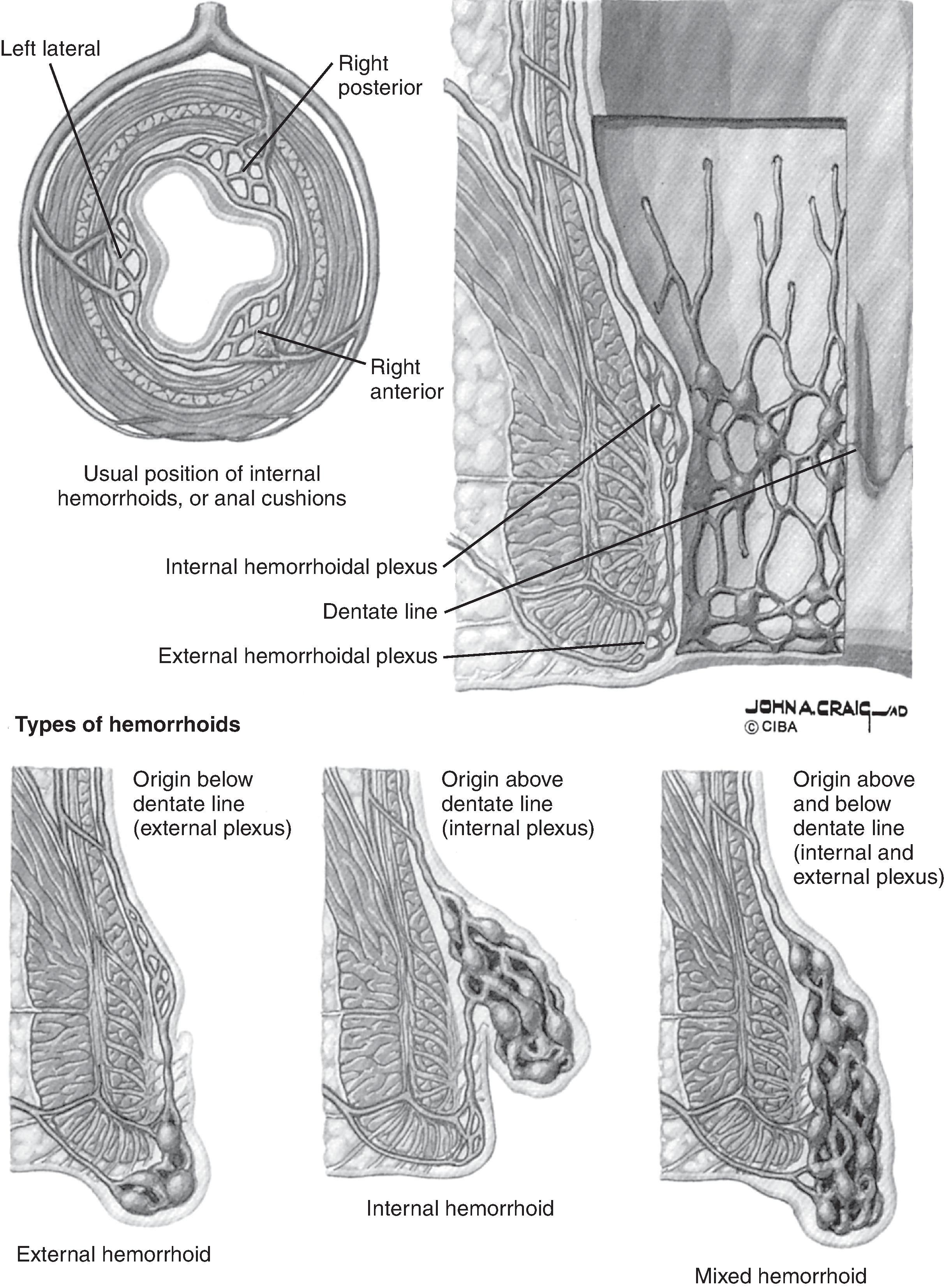
| Grade | Location | Symptoms |
|---|---|---|
| 1 | Bulge into anal canal | Painless bleeding |
| 2 | Prolapse, reduce spontaneously | Bleeding, pressure, itching |
| 3 | Prolapse, require manual reduction | Bleeding, pressure, mucoid drainage |
| 4 | Prolapse, cannot be reduced | Pain, bleeding, pressure, mucoid drainage |
Hemorrhoids are a normal part of human anatomy. Pathologic hemorrhoids occur as such through increased abdominal pressure, usually caused by constipation, straining, and poor toileting hygiene. Other causes for hemorrhoid enlargement and complications are diarrhea, pregnancy, chronic obstructive pulmonary disease (COPD), and portal hypertension (PH). Approximately 10 million Americans are affected by symptomatic hemorrhoids, making it roughly 4.4% of the population affected. The majority of these patients are over the age of 50.
Most patients with anorectal complaints will be labeled as having “hemorrhoids.” It is imperative that the practitioner differentiate hemorrhoidal symptoms from other benign or malignant anorectal conditions. Patients with rectal bleeding from hemorrhoids will describe bright red bleeding, usually with defecation. The blood can be minor and seen on the paper with wiping, or can fill the toilet bowl and include clots. Symptoms of constipation and straining or diarrhea should be elicited, and documenting bowel and toileting habits is a good place to start when evaluating these patients. Time spent on the toilet should be noted, and it should be discerned if this time is spent defecating, engaging in reading, and so on. It should be documented if the patient feels a prolapse of tissue and whether they need to manually reduce this. Hemorrhoidal prolapse should be easily differentiated from true rectal prolapse by the absence of circumferential folds and the presence of radial folds ( Fig. 2 ). A family history of colon cancer, polyps, or inflammatory bowel disease should be documented. Thorough examination of the anorectum (externally, digitally, and with anoscopy) should be performed. All patients with bleeding should have a discussion regarding colonoscopy. Patients with symptomatic external hemorrhoids are almost always suffering from thrombosis, and this may be solitary or in conjunction with strangulated internal hemorrhoids ( Fig. 3 ). It may be difficult to examine these patients because of discomfort and fear, and examination under anesthesia may be warranted. Skin tags are common and asymptomatic but may contribute to hygiene problems and pruritus ani.
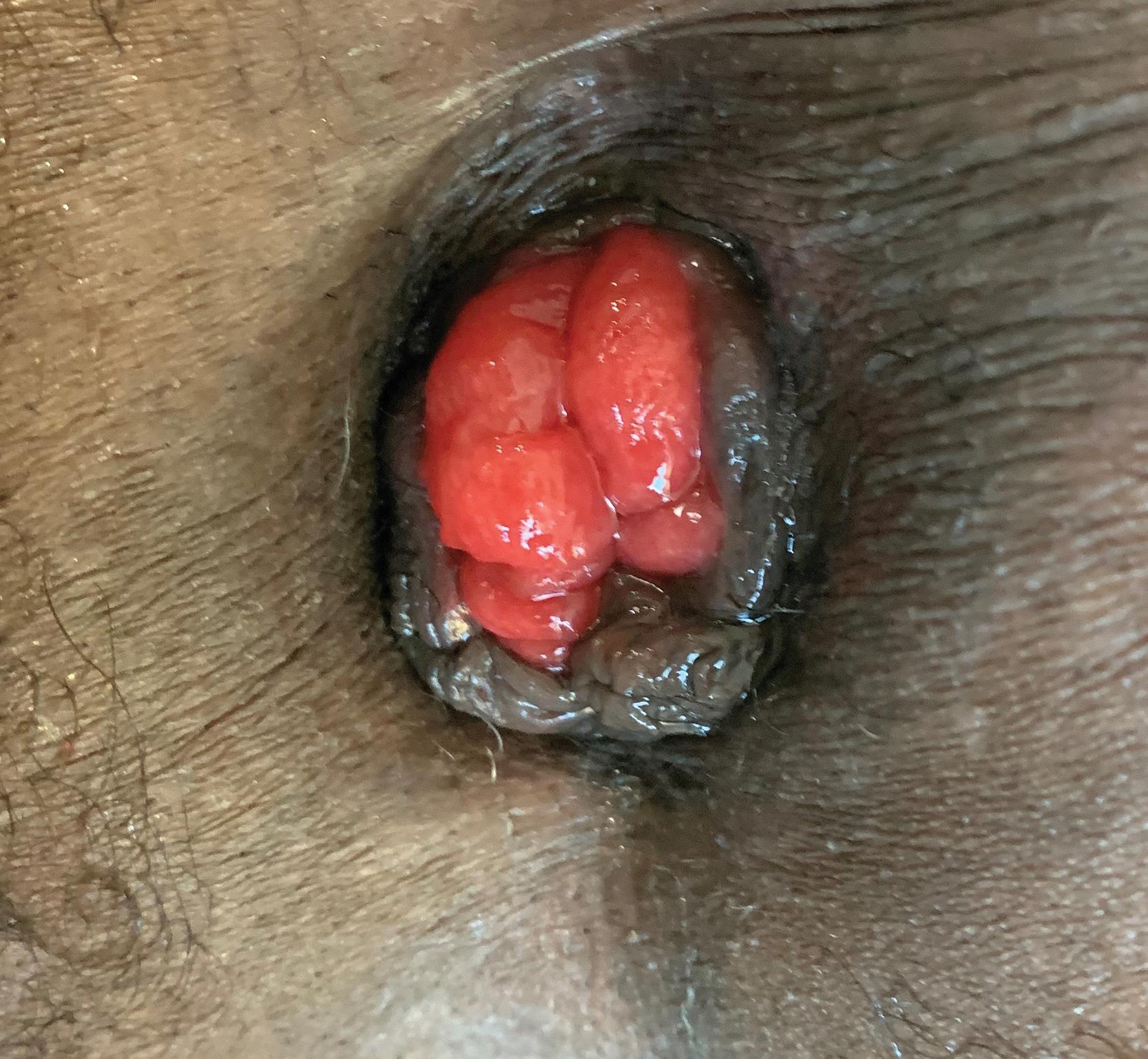
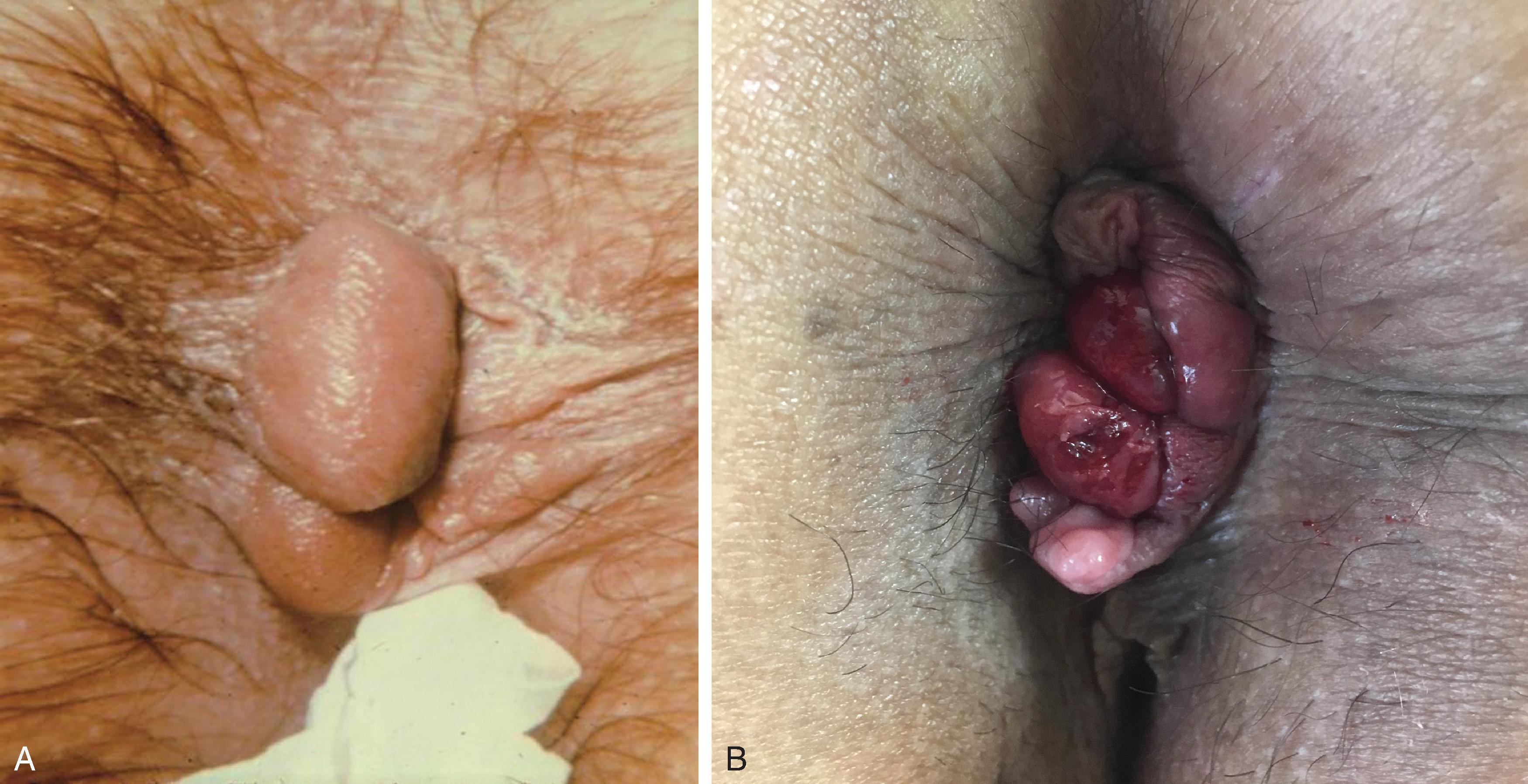
Once the patient has been diagnosed with symptomatic hemorrhoids and other conditions fully ruled out, first-line treatment with conservative, nonoperative therapy should commence. The vast majority of patients are started on a fiber supplement such as psyllium or methylcellulose and a stool softener such as docusate. Patients are encouraged to drink eight or more glasses of water per day, cut back on caffeinated beverages, and increase dietary fiber. Patients should also be advised on proper toileting hygiene as reducing pressure to the pelvic floor by avoiding straining is imperative. Patients are encouraged to reduce time on the toilet to less than 3 minutes and not to sit longer than necessary (no reading, cell phone, crossword puzzles). In a large systematic review, these simple measures were sufficient to decrease symptoms in the majority of patients with grade I and II hemorrhoids. Warm sitz baths two to three times daily may also help with symptom relief, as may application of cotton soaked with witch hazel to reduce edema. Over-the-counter topical remedies usually contain hydrocortisone or -caine analgesics and may provide temporary relief, but they do not help reduce symptoms in the long run.
The use of phlebotonics including the natural plant extract flavonoids are thought to improve hemorrhoids through an unknown mechanism of action. Studies report increased venous drainage and decreased hemorrhoidal inflammation. Patients report less bleeding, less pruritus, and overall symptom improvement. Long-term data do not exist to support durability at this time.
Some patients will fail conservative treatment and require procedural intervention. Office-based procedures include rubber band ligation (RBL), sclerotherapy, infrared coagulation (IRC), and use of the HET bipolar system. Operative procedures are also included in the algorithm of treatment and may be employed as more conservative treatments fail.
RBL is the most common office-based procedure for symptomatic hemorrhoids. It is appropriate for use on grade I, II, or III hemorrhoids and requires no anesthetic or bowel preparation. Patients who are on anticoagulation, on antiplatelet therapy, or are allergic to latex are not eligible for this procedure. With the former, there is a risk of delayed bleeding. Patients are asked to abstain from aspirin-containing products at home for 7 days before the procedure. They are placed in the left lateral decubitus or prone jack-knife (preferred) position on a procto table. Anoscopy is performed, and the hemorrhoids are visualized. The largest or most excoriated hemorrhoid is addressed at the first session. The rubber band is placed approximately 2 cm above the dentate line at the apex of the hemorrhoid ( Fig. 4 ). There is no somatic pain sensation at this level, and many patients report dull pelvic pressure.
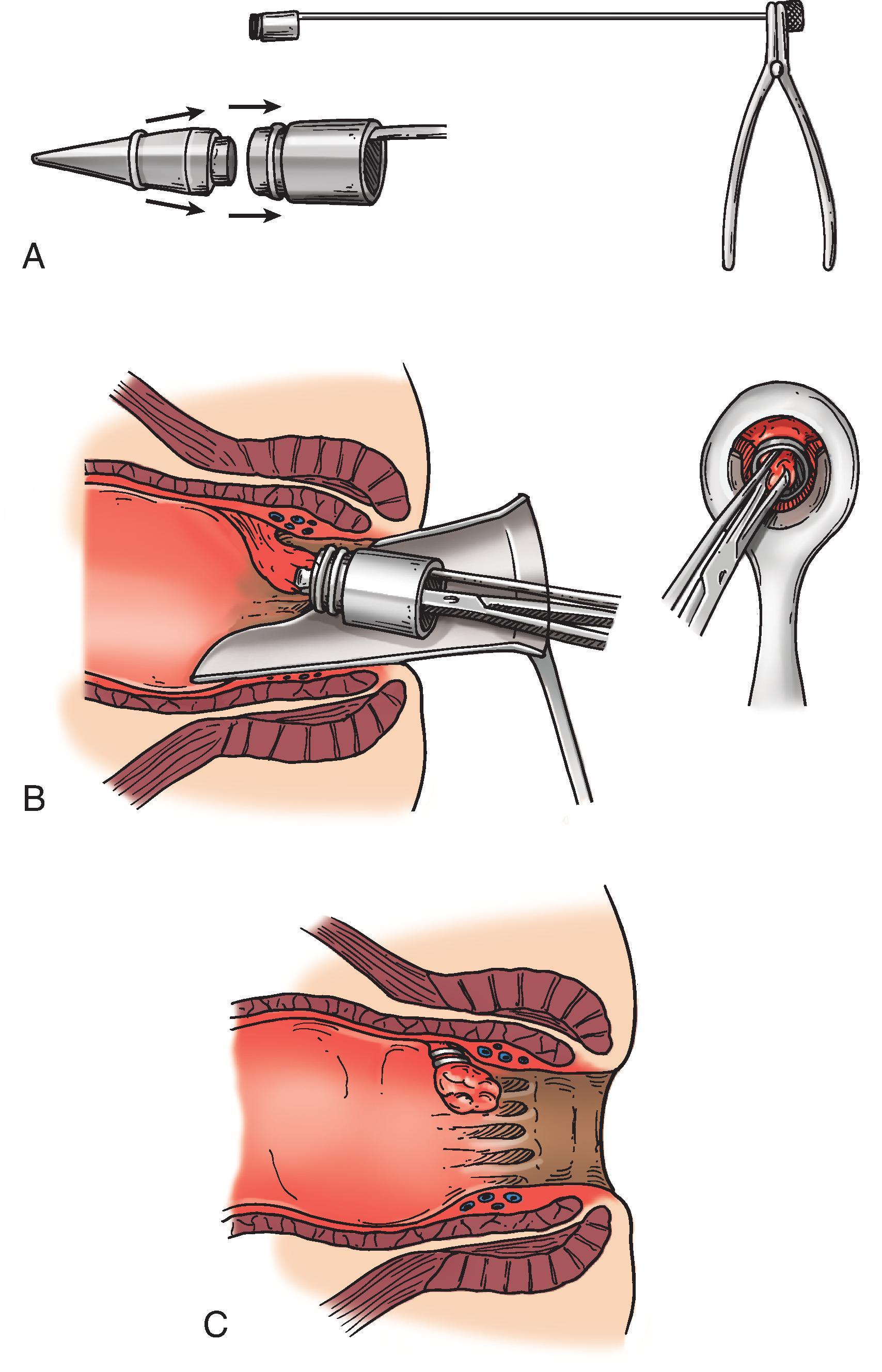
There are several types of rubber band ligators available; our preference is shown. Suction ligators have the benefit of not needing an assistant. RBL helps reduce hemorrhoid size by reducing blood flow to the hemorrhoidal cushion and by removing a small portion of rectal mucosa. Over time, fibrosis and scarring occur, which help pull the hemorrhoid cephalad and further reduce size and prolapse symptoms. Hemorrhoid banding has a high success rate of over 90%. Many patients may need a series of bandings to fully address symptoms; these should be scheduled roughly 3 to 4 weeks apart. Our preference is to band one hemorrhoid at the first occasion and up to two thereafter. We avoid banding all three hemorrhoidal columns to reduce pelvic pressure and pain. The band will slough in approximately 1 week, causing some minor bleeding. Again, it is this part of the procedure that makes it unsuitable for those on anticoagulants or aspirin. For those who can stop anticoagulation 1 week before and after, banding is a good option. For those who cannot, sclerotherapy can be offered.
RBL is safe, and its most common complications are pain, bleeding, vasovagal symptoms, or thrombosis of the contiguous external hemorrhoid. Severe pain immediately after banding indicates the band was placed too low, and band removal is required either in the operating room or with a band-removing tool in the office. Rarely, pelvic sepsis can occur with fever, increasing and severe pain, and urinary retention. It is a rare but serious complication and requires immediate operative intervention to control sepsis with wide debridement of necrotic tissue.
Sclerotherapy is an office-based procedure used for grade I and II hemorrhoids and is a viable option for patients on anticoagulants and antiplatelet agents. A sclerosant is injected into the hemorrhoid, resulting in shrinkage, fibrosis, scarring, and fixation. Sclerosing agents include 5% phenol (suspended in almond oil), hypertonic saline, or ethanolamine. Anoscopy is performed and, using a 25-gauge needle, the surgeon injects the sclerosant 1 cm above the dentate line in the submucosa of the hemorrhoid. The volume injected varies based on the sclerosant but is typically 2 to 3 mL when using phenol and 1 mL when using ethanolamine, and all three hemorrhoids can be treated in one session. Digital pressure is used to control needle site bleeding in patients who are anticoagulated. Sclerotherapy, like RBL, can be repeated to achieve the desired effect. Complications are similar to RBL and arise usually from injecting the sclerosant into the muscle or mucosa, which leads to pain, ulceration, and eventual sloughing of the mucosa.
IRC and bipolar diathermy are also utilized for grade I and II hemorrhoids. Like sclerotherapy, both can treat all hemorrhoid columns in one setting. In IRC, the tip of the infrared coagulator (IRC 2100, Redfield Corporation) is placed at the apex of the hemorrhoid. A 1- to 1.5-second pulse is applied, resulting in a 4-mm 2 focus of coagulation. This creates a 2.5-mm-deep ulcer. Typically three to four applications are made on each hemorrhoid. The overall effect is thrombosis and tissue destruction, which leads to shrinkage, scarring, and fixation of the hemorrhoid. IRC is well tolerated and has similar side effects to RBL and sclerotherapy ( Fig. 5 ).
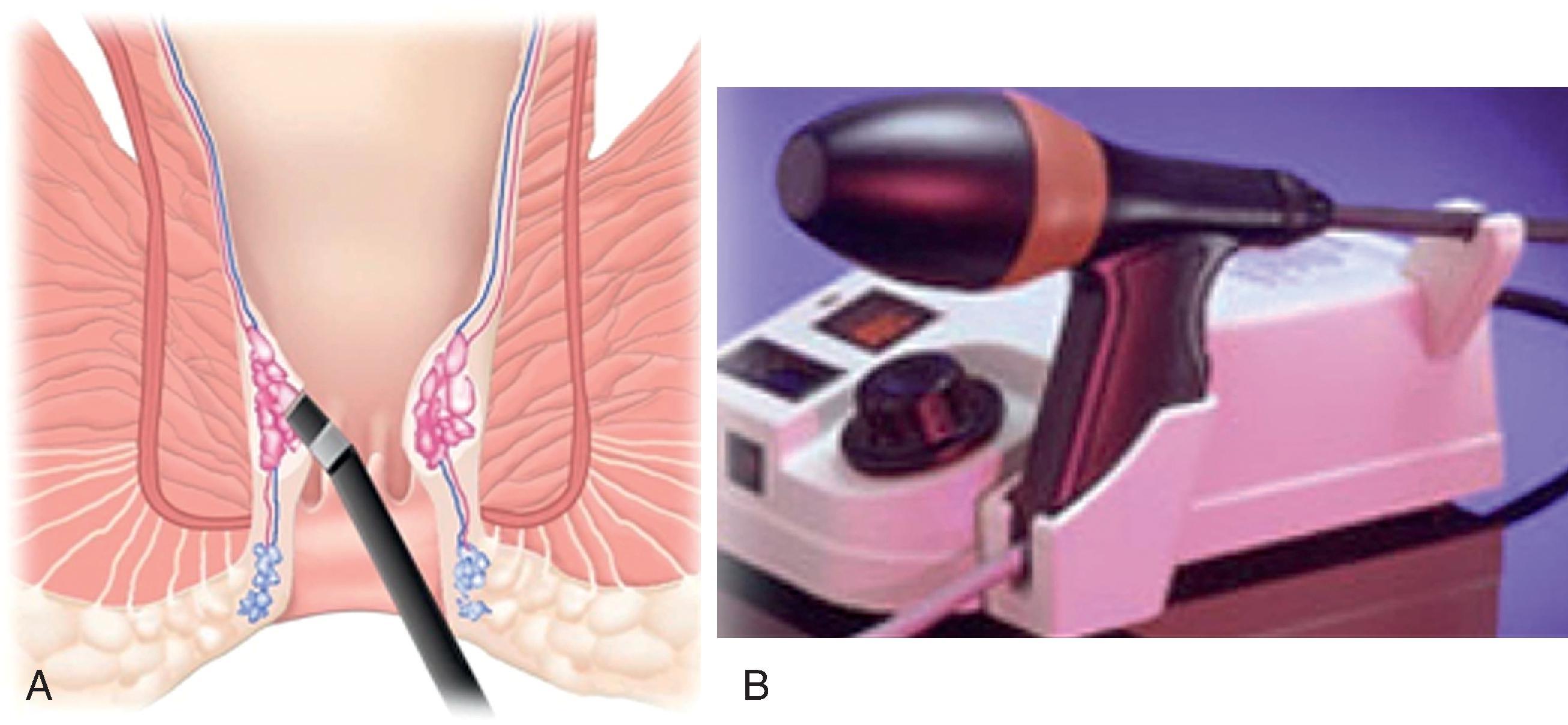
The HET system (HET bipolar system, Covidien) is also used in the office setting. Using specialized forceps, the hemorrhoid is grasped, and bipolar energy is applied. HET is well tolerated and has similar side effects to RBL and sclerotherapy.
Operative treatment is indicated for patients with grade III and grade IV hemorrhoids and for those who have persistent symptoms despite conservative and office-based procedures. Some patients are suitable to go directly to an operation in the nonurgent setting. Only about 5% to 10% of patients with symptomatic hemorrhoids will require an operation. Surgery is superior to office-based procedures in terms of durability but has more potential complications including pain, urinary retention, bleeding, anal stenosis, infection, and changes in continence. Use of long-acting injectable anesthetics is helpful. Detailed postoperative instructions including pain management, local wound care, controlling constipation, and return precautions are important for patient satisfaction and comfort in the postoperative period.
The term acute hemorrhoidal crisis is attributed to Dr. Eugene Salvati, whose robust practice of over 50 years focused heavily on proctology. Acute hemorrhoidal crisis refers to circumferential prolapsed, thrombosed, and incarcerated internal and external hemorrhoids, with or without necrosis. In the absence of necrosis, the patient can be treated definitively or temporized with the use of an injected mixture of 1% lidocaine with epinephrine, normal saline, and hyaluronidase. The mixture is injected into all edematous tissues. The area is massaged, and a pressure dressing is applied. We typically have the patient sit on a roll of kerlix. The procedure can be repeated ( Fig. 6 ). With necrosis present, this should be managed operatively with hemorrhoidectomy. Before incision, the hyaluronidase mixture can be injected and the hemorrhoids reduced to better delineate the tissues that are necessary for excision and reduce the chances for overexcision of anoderm. Single-column thrombosis can be excised and the wound left open to granulate. This is best done within the first 72 hours of thrombosis, and patients should be counseled that pain and drainage will be present after the procedure ( Fig. 7 ).
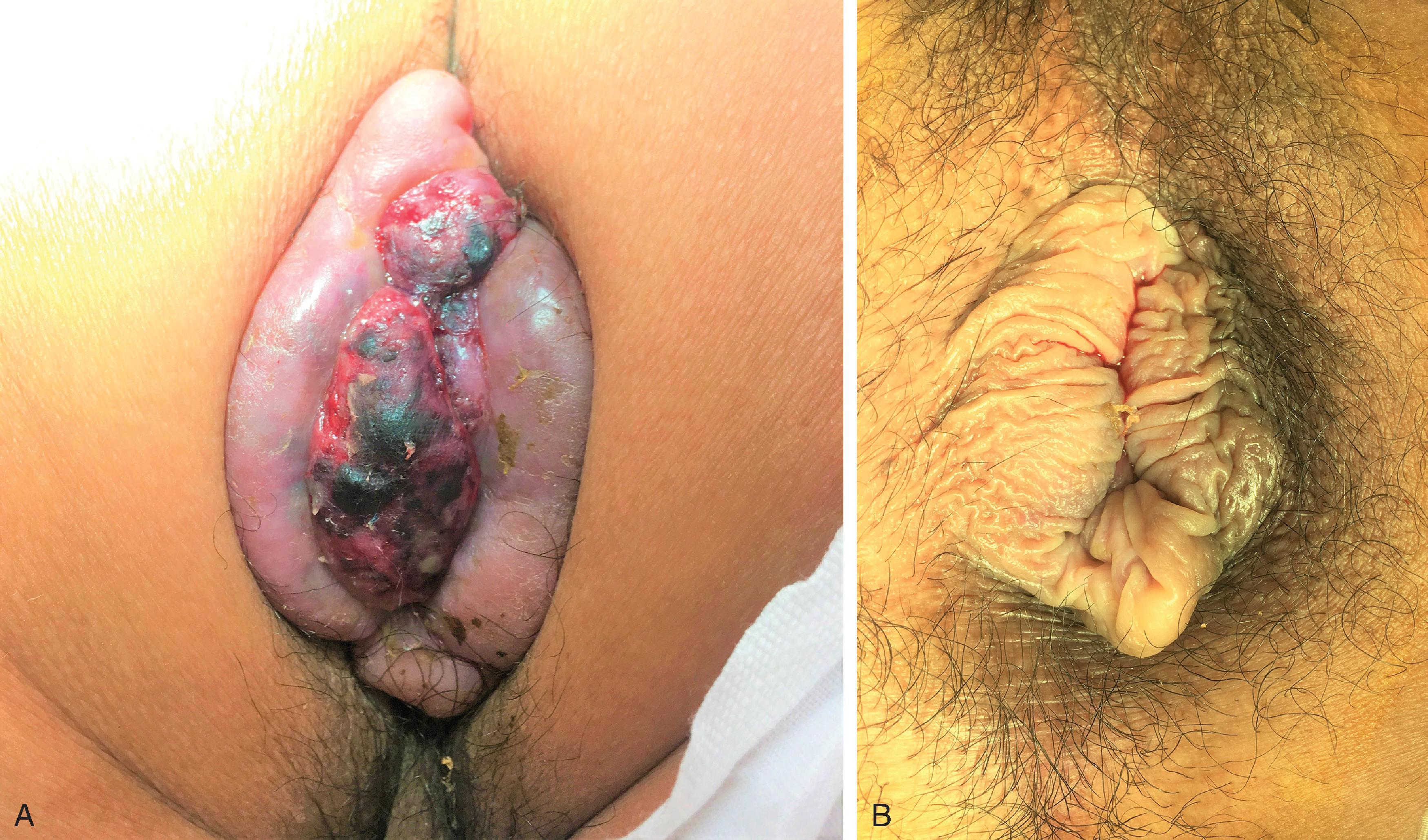
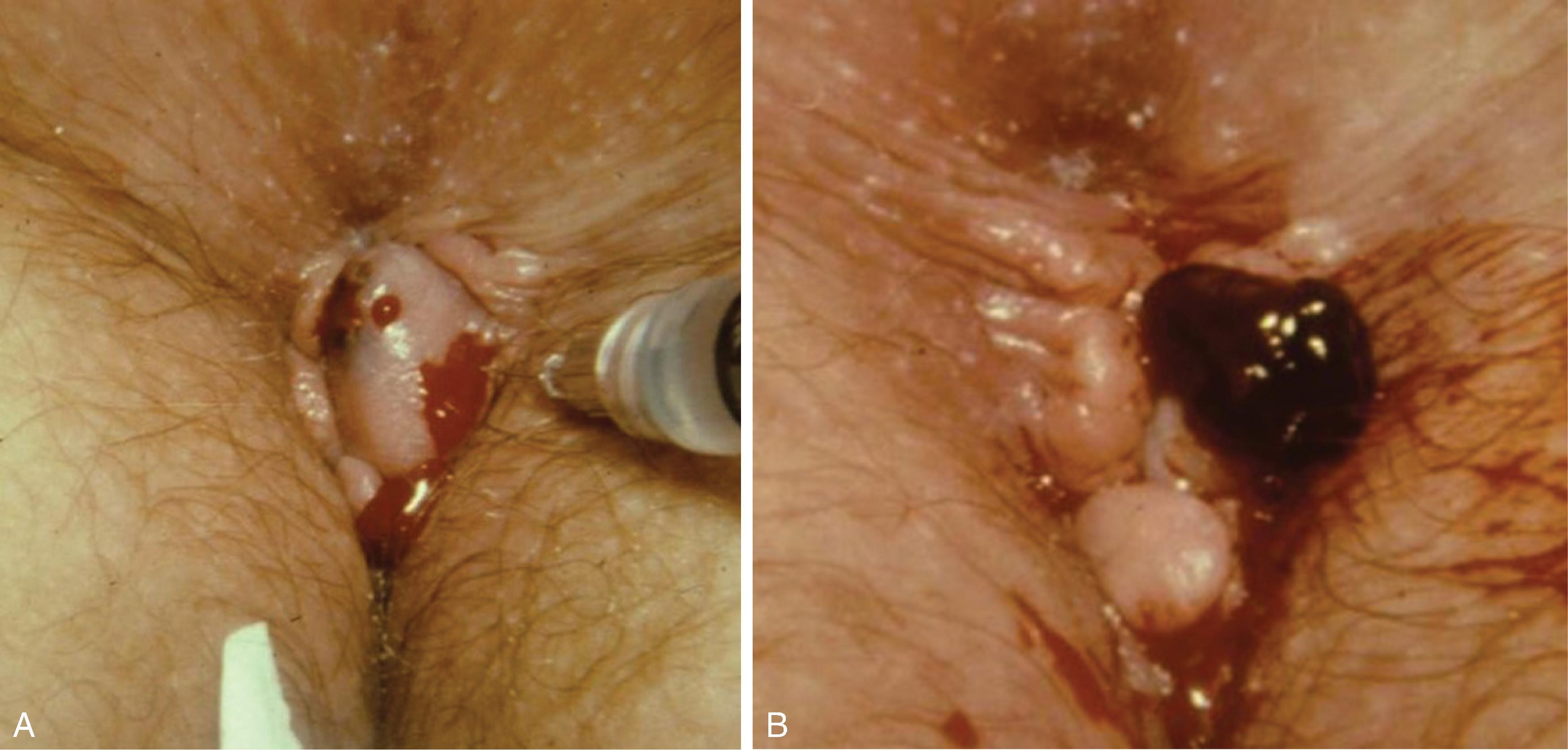
The Ferguson or “closed” hemorrhoidectomy is the most common hemorrhoid operation performed in the United States and offers a durable solution to hemorrhoidal symptoms. It involves excision of the hemorrhoidal tissue (internal and external) with ligation of the hemorrhoid pedicle and closure of the mucosal defect and skin. Our preference is to perform this operation under spinal anesthesia with the patient in the prone jack-knife position. The hemorrhoid is marked for excision at the anoderm. It is injected with an equal mixture of lidocaine with epinephrine and bupivacaine. A V - shaped incision is made in the perianal skin, and the hemorrhoid is elevated off the external and internal sphincter as the dissection is carried cephalad. The sphincter muscles should be clearly identified in situ as the incision is continued onto the mucosa. The apex of the hemorrhoid is identified, and the vascular pedicle is clamped before excision of the hemorrhoid. The pedicle is suture ligated (we use 2-0 Vicryl on a tapered needle), and the defect is then closed using a locking running suture until reaching the skin, where simple running sutures complete the closure. The last few millimeters are left open to drain ( Fig. 8 ). The procedure can also be performed using a bipolar sealing device (LigaSure or Harmonic). Careful identification of the internal sphincter is mandatory to proceed safely with this technology, and caution must be used to prevent overexcision of anoderm with resultant anal stenosis. Using an energy device will also significantly increase cost.
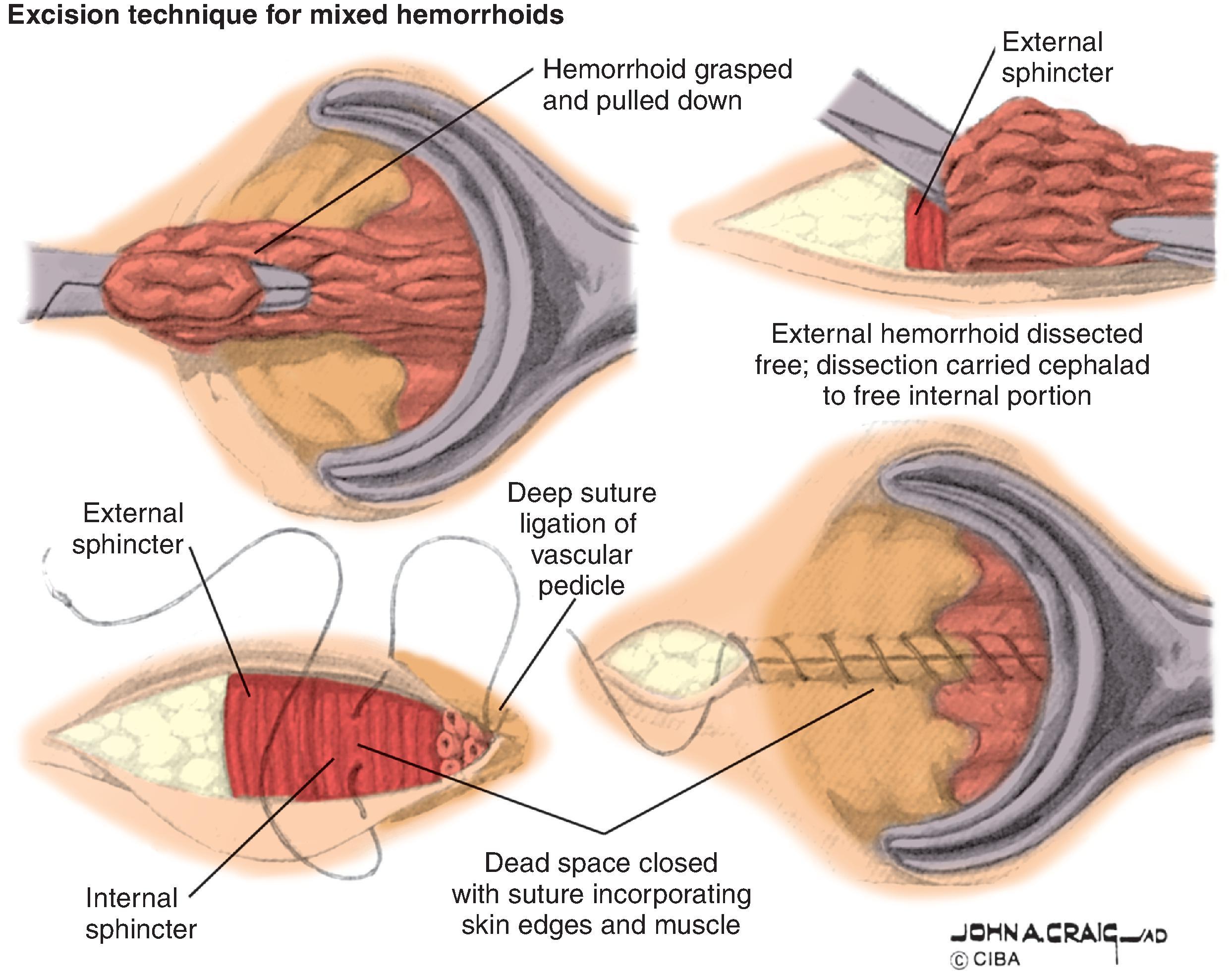
The Milligan-Morgan, or “open” hemorrhoidectomy, is performed most commonly in Europe and the United Kingdom. The procedure is identical to the Ferguson hemorrhoidectomy, but after excision the wound is left open to heal by secondary intention. Outcomes and overall durability are similar, but wound healing is much longer.
Stapled hemorrhoidopexy (or procedure for prolapsed hemorrhoids [PPH]) is usually offered to patients with grades I to III circumferential internal hemorrhoids without a bulky external component. It was developed as an alternative to excisional hemorrhoidectomy because of the associated postoperative pain. The technique uses a specialized circular end-to-end anastomosis (EEA) stapler that removes a circumferential band of mucosa and submucosa proximal to the hemorrhoids. It does not remove the hemorrhoids, but flattens them with tension and disruption of the vascular pedicle and helps reposition them back to their normal anatomic position in the anal canal. There are no external wounds, and the staple line is cephalad to the dentate line, thus reducing pain compared with traditional excisional hemorrhoidectomy. PPH can help flatten external disease, but it will not completely address large external hemorrhoids.
Stapled hemorrhoidopexy is also performed under spinal anesthesia in the prone jack-knife position. The hemorrhoidopexy kit contains a dilator, a clear plastic anoscope, an operating anoscope, and stapler ( Fig. 9 ). The dilator is placed in the anal canal, and the clear plastic anoscope is sutured to the perianal skin to evert the dentate line. Next, the operating anoscope with depth markings is used to place a circumferential submucosal purse-string suture 3 to 4 cm proximal to the dentate line, about 2 cm proximal to the hemorrhoidal pedicle. Caution must be taken to avoid placing a full-thickness suture, especially in women as injury to the vagina and subsequent rectovaginal fistula can occur. After placement of the purse-string suture, the vagina should be checked digitally to ensure the absence of suture. Once the purse-string suture is complete, it is tied to the anvil of the stapler. The anvil is then mated with the stapler, and the stapler is fired. The specimen appears as a ring of mucosa and submucosa.
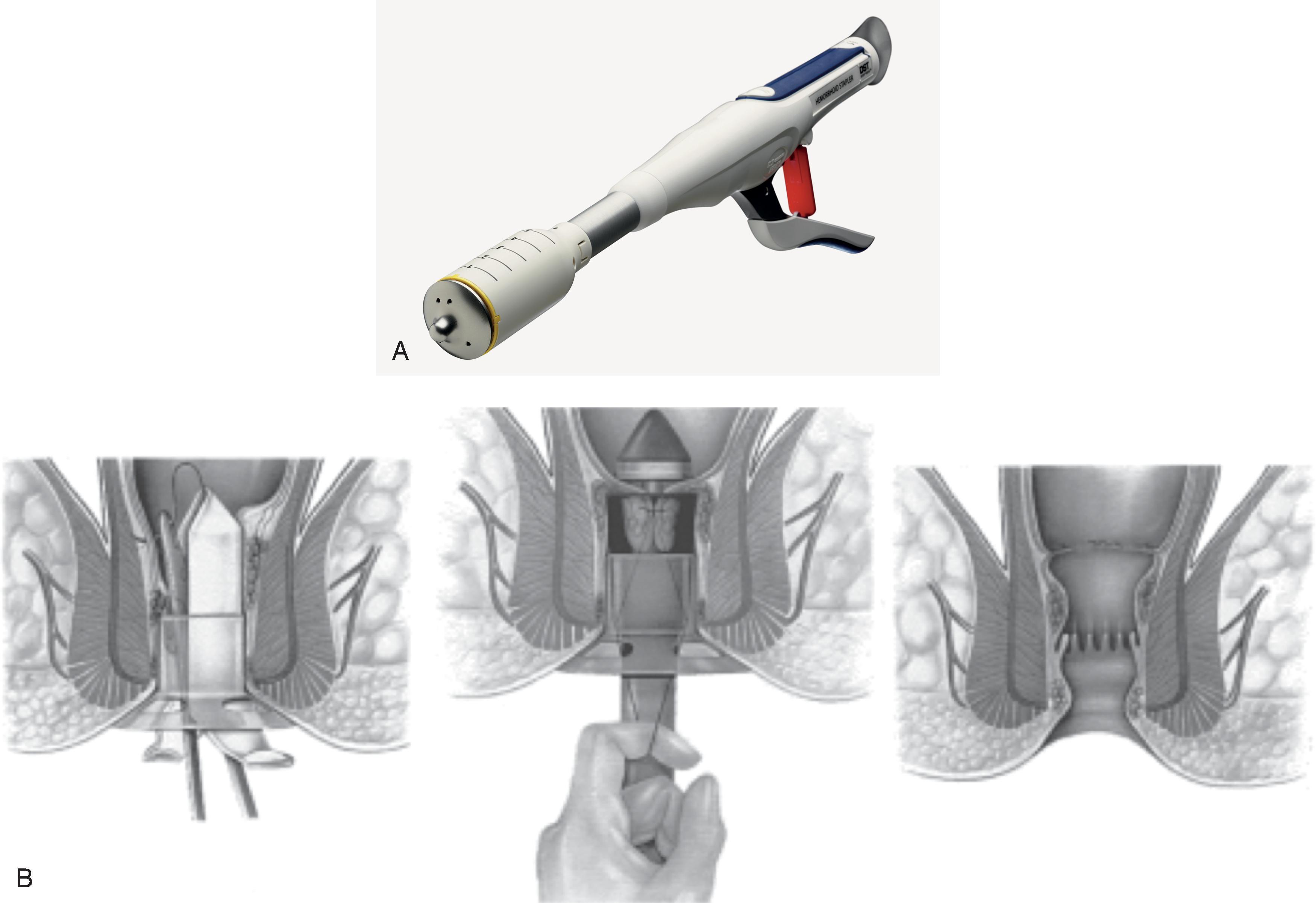
Complications of PPH and excisional hemorrhoidectomy are similar. In some cases, if the staple line is too close to the dentate line, the patient will have significant postoperative pain, so care must be taken to place the purse-string suture at the correct level. Staple line bleeding at the time of the initial operation should be controlled by oversewing the entire staple line. Rare complications such as rectovaginal fistula, pelvic sepsis, staple line stricture, and rectal perforation have been reported, and most complications result from misplacement of the purse-string suture. PPH outcomes are similar to hemorrhoidectomy however; long-term recurrence is higher with stapled hemorrhoidopexy. Overall, PPH patients have less pain, faster recovery, and better quality of life scores compared with excisional hemorrhoidectomy patients.
Doppler-guided hemorrhoidal artery ligation (DGHAL) is a technique that utilizes one of two patented anoscopes, the THD (transanal hemorrhoid dearterialization) or the HAL (hemorrhoid artery ligation). Both systems utilize Doppler guidance to isolate the hemorrhoidal arteries for ligation. Typically used on grade II to III hemorrhoids, it allows selective and specific ligation of the hemorrhoidal arteries, reducing arterial inflow to the hemorrhoids and returning the tissues to normal physiologic condition. Up to 90% of patients had improved symptoms, with less postoperative pain than other surgical options, because all suturing is done proximal to the dentate line.
Similar to other hemorrhoid procedures, the DGHAL is performed in the operating room in the prone jack-knife position. The proprietary anoscope is placed in the anal canal to 6 to 7 cm from the anorectal junction. The vessels are localized with the attached Doppler, usually about 2 cm above the anorectal junction ( Fig. 10 ). A Z- stitch is placed at this location through the slot on the anoscope, and ultimately six sutures are placed. For patients with grade III or IV hemorrhoids, a mucopexy, or “rectoanal repair,” can be added to help draw up and flatten out the tissues. Overall complication rates are low and are mostly related to bleeding and recurrence.
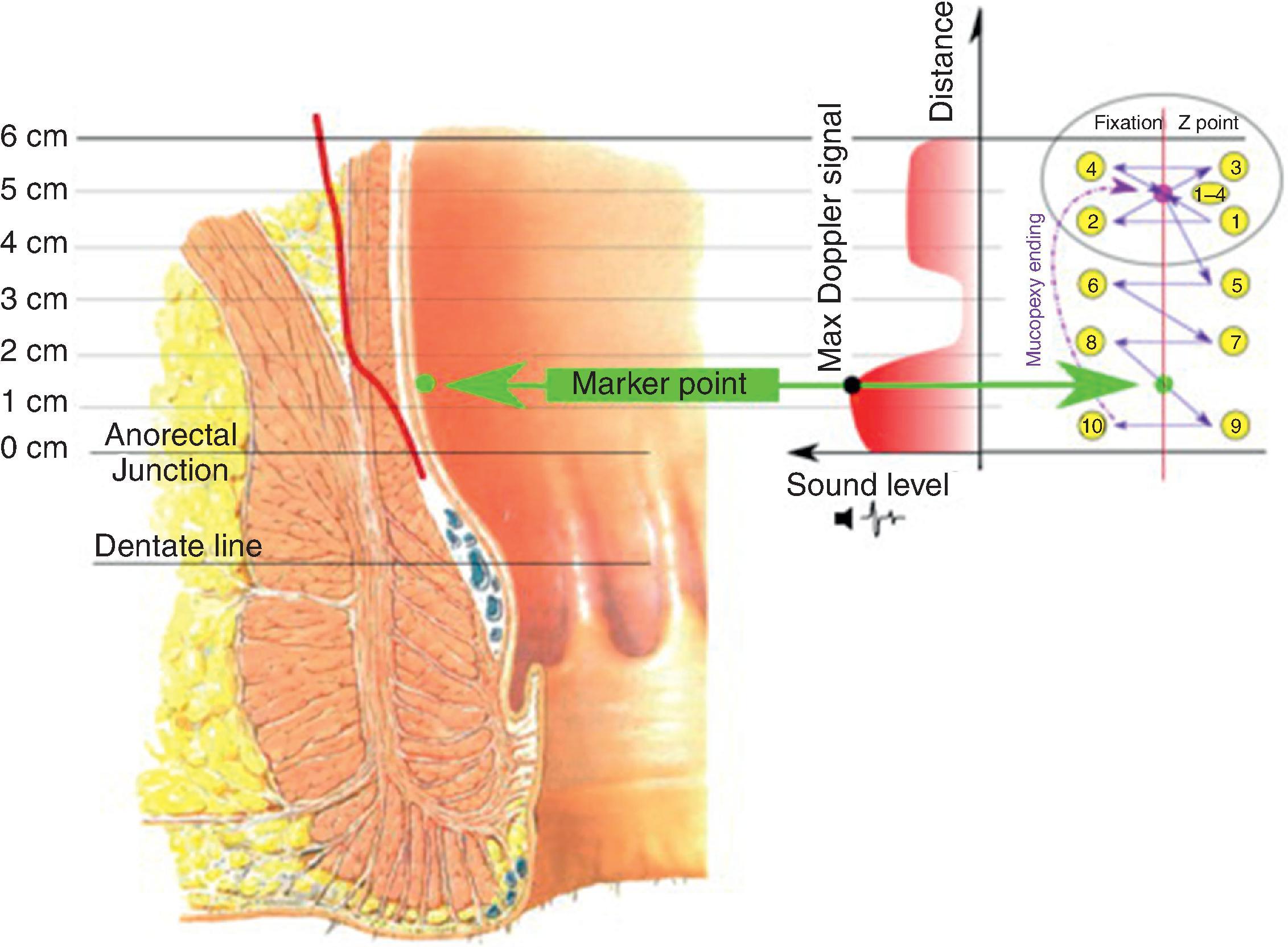
Open transanal hemorrhoidopexy can be performed alone or in conjunction with other operative procedures. It involves suturing the anal mucosa to the rectal wall using a Z- stitch. At 4 cm from the anal verge, a suture including mucosa and submucosa is placed through the rectal wall and then at the upper level of the hemorrhoid tissue near the vascular pedicle. Before tying the suture, a 1-cm strip of mucosa between the two sutures is excised after injection of lidocaine with epinephrine. The suture is then tied down, drawing the prolapsing hemorrhoid higher into the anal canal. Our practice is to perform this procedure, with or without excision of the intervening tissue, during other operative treatment for the hemorrhoids, and it can be a useful adjunct. Complications related to bleeding and thrombosis are most common. Recurrences may be managed with a repeat procedure.
Surgical hemorrhoidectomy is a very safe procedure. Postoperative urinary retention occurs in up to 15% of patients and can be partially mitigated with fluid restriction. Postoperative bleeding occurs in 1% to 2% of patients. Early bleeding is considered an operative complication, but bleeding 7 to 14 days later is a known complication resulting from absorption of sutures. All patients with significant bleeding must return to the operating room. During the examination under anesthesia, most often no active bleeding is seen, but all suture or staple lines should be oversewn. Rarely more serious complications will occur as mentioned previously. Overall, most patients will have postoperative pain and should be given multimodal analgesics to help reduce narcotic usage. Oral regimens of nonsteroidal antiinflammatory drugs (NSAIDs) as well as acetaminophen should be given around the clock. Sitz baths to help reduce discomfort should be utilized liberally. Constipation and diarrhea should be avoided, and appropriate stool modifiers should be offered if necessary. Studies have shown that use of topical calcium channel blockers in the postoperative period reduced overall pain and allowed patients to resume normal activities sooner. Overwhelmingly the greatest improvement has been with the use of liposomal bupivacaine, which has demonstrated overall reduction of pain scores and greater interval in opioid usage in the postoperative period.
Pregnant patients are susceptible to increased hemorrhoid symptoms because of the complex physiologic changes that result in increased intraabdominal pressure and reduced venous return. Labor-related straining further complicates the problem. Bleeding and pain are the most common symptoms, and symptoms present at any time during pregnancy, but most often in the third trimester.
Treatment is almost always conservative and nonoperative as most hemorrhoid symptoms will regress in the postpartum period. Unless the hemorrhoids are thrombosed or strangulated, surgery should be avoided. Stool softeners, sitz baths, and cooling ointments should be used liberally.
PH is another condition that will result in increased rectal bleeding, and many of these patients have rectal varices on examination that may resemble hemorrhoids. Bleeding in the setting of PH should be treated conservatively. RBL is contraindicated because of the risk of delayed bleeding. Sclerotherapy and suture ligation of the hemorrhoids can be offered if conservative therapy fails. Ultimately, reducing portal pressure with a transjugular intrahepatic portosystemic shunt is the terminal procedure. Caution should be taken to avoid any bedside or office-based procedures in these patients because bleeding, even from small injection sites, can be brisk and difficult to control.
Managing hemorrhoid symptoms in immunocompromised patients can be challenging. Conservative measures are first line as the risk of poor wound healing and pelvic sepsis is increased after surgical hemorrhoidectomy in this cohort. For patients on immunosuppressants that can be stopped, preference is to have 1 week off medication before the procedure. In patients with poorly controlled HIV or AIDS, sclerotherapy is the procedure of choice. Preprocedure antibiotics should be considered in this population and discussed with the patient and the patient’s other physicians. Patients with well-controlled HIV have a risk similar to non-HIV patients.
In patients with Crohn’s disease, symptomatic hemorrhoids are rare. Symptoms are more likely related to the Crohn’s disease when a careful history and examination are made. Anal fissure and anorectal abscess are much more common than symptomatic hemorrhoids. Treatment should always be conservative, and maximal management of the Crohn’s disease is imperative. Elective operations for hemorrhoids in patients with proctitis should be avoided. Acute, painful thrombosis may be excised with a small incision.
Hemorrhoidal disease is very common among adults in the United States given the incidence of constipation and low-fiber diet. Symptoms must be carefully elucidated by the physician, and a thorough physical examination and anoscopy are crucial to confirming the diagnosis. Colonoscopy should be ordered to confirm outlet bleeding and rule out proximal source. Conservative management with dietary and lifestyle changes are the mainstay of treatment in every patient. Fiber supplementation and proper toilet hygiene are imperative. When failure of conservative therapy is noted, patients with grade I to II hemorrhoids and some with grade III will benefit from office-based procedures. They can be repeated safely to obtain optimal results. Those with grade III and IV hemorrhoids or who fail office-based procedures have multiple surgical options depending on anatomy and patient preference. The operation should be tailored to the patient. Care should be taken when managing patients with special circumstances as not every procedure is suitable.
Anal fissures are one of the most common conditions seen in a colorectal surgery practice. Patients present with sharp tearing or cutting pain during and after bowel movements, often accompanied by hematochezia. The pathogenesis is believed to be precipitated by hard stool or diarrhea passing through the anal canal, causing mucosal trauma. The trauma causes pain and tightening of the sphincter. Increased sphincter tone and decreased blood flow along with repeated trauma prevent fissures from healing, forming the key targets for treatment.
On anorectal examination, 75% to 90% are located in the posterior midline, and acute fissures appear as a longitudinal tear in the anal canal, distal to the dentate line ( Fig. 1A ). After 6 to 8 weeks, chronic fissures may present with a skin tag or sentinel pile, with exposed fibers of the internal sphincter visible at the base, and heaped-up granulation tissue at the edges ( Fig. 1B ). Up to 20% may be located in the anterior midline, and off-midline fissures should prompt evaluation into other underlying infectious, immunosuppressive, or malignant etiologies ( Fig. 1C ).
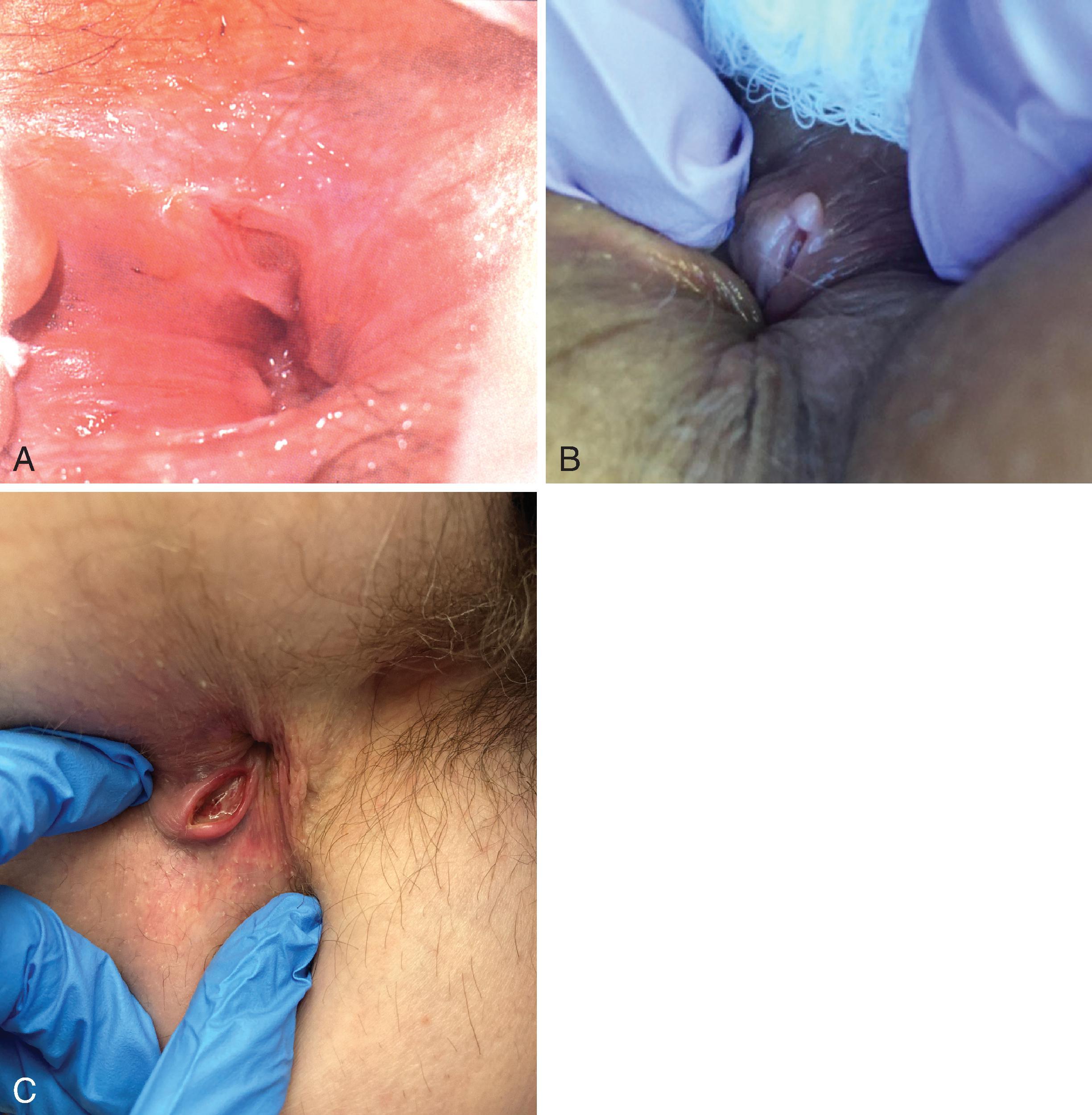
There is no single recommendation for treatment that is best for all patients. Nonoperative treatment success will partially depend on patient compliance with lifestyle modifications and topical agents. The decision to escalate to surgery involves the degree of improvement with conservative measures, the risk for incontinence, and patient preference. For severely symptomatic patients who do not have risk factors for incontinence and can accept a small risk of long-term incontinence, surgery may be offered up front for the highest likelihood of healing and lowest risk of recurrence. It is our preference to only use this in very select cases.
Over 50% of acute fissures will resolve with conservative measures and warrant a trial of nonoperative management. Initial recommendations include increased fiber intake (25 to 35 g per day) via diet or supplements, increased hydration, and warm sitz baths. Fiber combined with sitz baths alone has been reported to heal up to 87% of acute fissures. The combination of these conservative measures with a topical analgesic (e.g., 2% lidocaine, EMLA cream) and a sphincter relaxant is a reasonable first-line treatment. Failure of symptoms to improve in 6 to 8 weeks warrants reevaluation and escalation of treatment. A biopsy should be performed on all longstanding fissures to rule out malignancy.
Topical nitroglycerin releases nitric oxide and relaxes the internal anal sphincter (IAS), producing healing rates between 49% and 68%. Doses between 0.2% and 0.8% can be applied 2 to 4 times per day. However, effects are short-lasting (approximately 90 minutes), which may require diligence and frequent reapplication. The most significant side effect is headaches and lightheadedness, which may be mild to severely disabling and can lead to noncompliance and cessation of treatment.
Topical gels containing nifedipine or diltiazem similarly relax the internal sphincter and encourage blood flow. Oral doses are available but may lead to orthostatic hypotension. Studies comparing topical nitrates to calcium channel blockers have showed conflicting results, and both are considered equivalent, with selection largely based on provider preference and pharmacy availability. We prefer a dose of 2% to 5% topical diltiazem cream applied 2 to 3 times daily. If tolerated, oral doses of 60 mg twice-daily have been successfully described.
Botulinum A toxin (Botox, Allergan Inc.) chemically paralyzes the internal sphincter, which lowers the resting anal pressure and increases blood flow. Injections can be performed as an outpatient or clinic-based procedure. We prefer treatment with 60 to 100 units diluted in 2 to 5 mL sterile saline solution. Four divided doses are injected into the intersphincteric groove directed toward the IAS in four quadrants. Depending on sphincter tone, another 1 mL is injected on either side of the fissure ( Fig. 2 ).
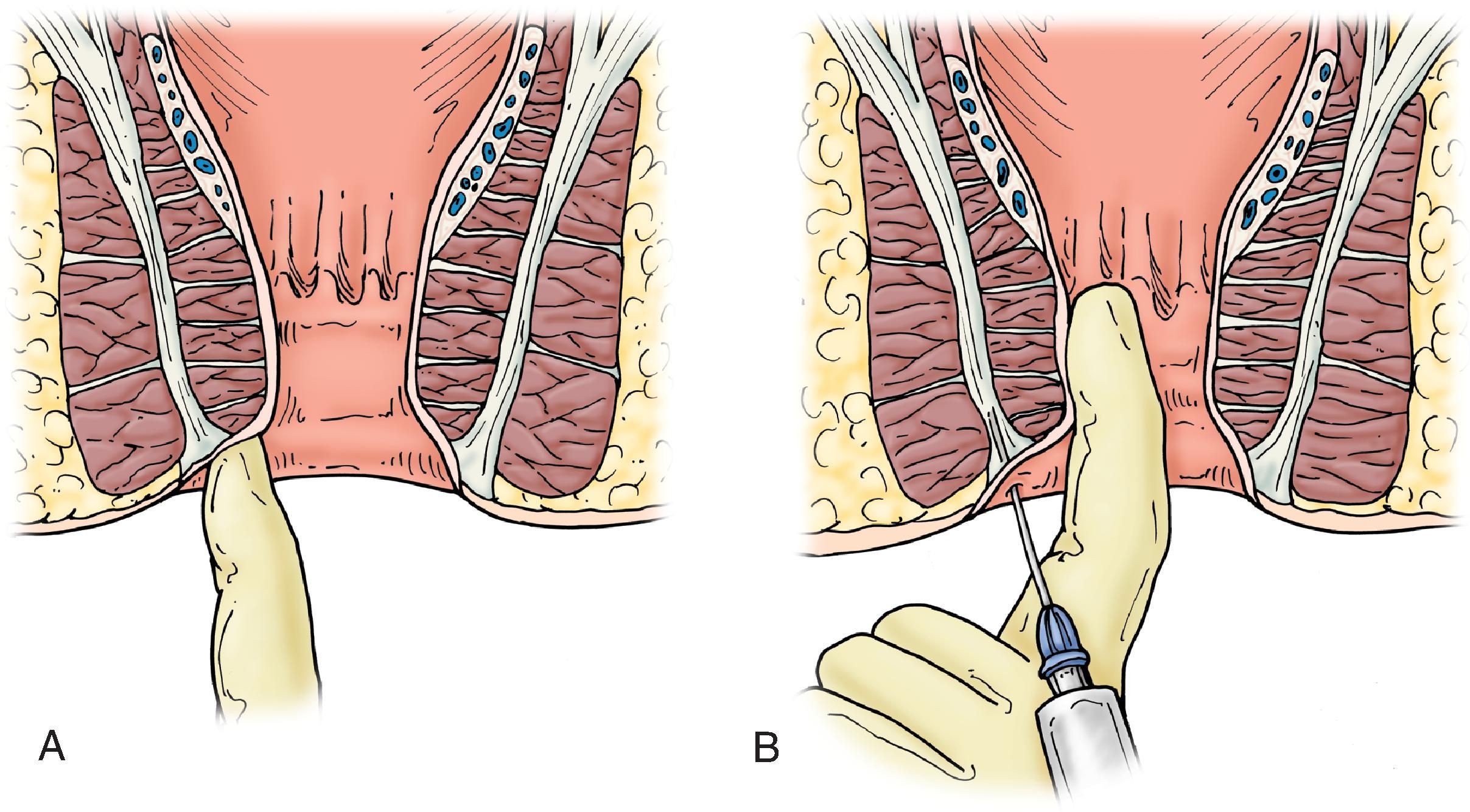
Effects of Botox are not compromised with patient noncompliance, and results are longer-lasting than topical relaxants. However, the long-term durability of cure is not as clear, and recurrence has been reported to be as high as 40% at 4 years. Nevertheless, there are decreased rates of permanent incontinence compared with surgical sphincterotomy. In a Cochrane review of nonsurgical therapy for anal fissure including 23 studies and 1236 patients, topical nitroglycerin was found to be better than placebo in healing fissures (49% vs. 36%, P < 0.0009), though nearly 50% of those initially cured had a recurrence. Botox and calcium channel blockers were equally efficacious to nitroglycerin and benefited from fewer adverse events. Overall, no medical therapy approached the superior efficacy of surgical sphincterotomy.
Manual dilation of the sphincter muscle using fingers, various retractors, and pneumatic balloons has been abandoned secondary to poor outcomes including incontinence, recurrence, trauma, and patient discomfort. Fissurectomy has been proposed to address the chronic anatomic changes that may prevent a fissure from healing. Minimal debridement or “trimming” eliminates the fibrosis, sentinel pile, and rolled edges back to healthy tissue that may encourage a fissure to heal. It has limited success when used alone but may be performed in conjunction with chemical denervation, sphincterotomy, or advancement flaps.
LIS is the gold standard surgical treatment for chronic fissures, offering the highest rates of healing (up to 95%) and low recurrence with durable results. It can be performed as an open or closed approach, with equivalent rates of healing and recurrence. In a Cochrane review of 2056 patients in 27 studies analyzing 13 different procedures, there was no difference between open versus closed LIS in fissure persistence and incontinence risk.
In the open approach, a small radial incision is made over the intersphincteric groove. The internal sphincter muscle is dissected out and exposed before dividing under direct visualization ( Fig. 3 ). The overlying incision can then be closed with an absorbable suture.
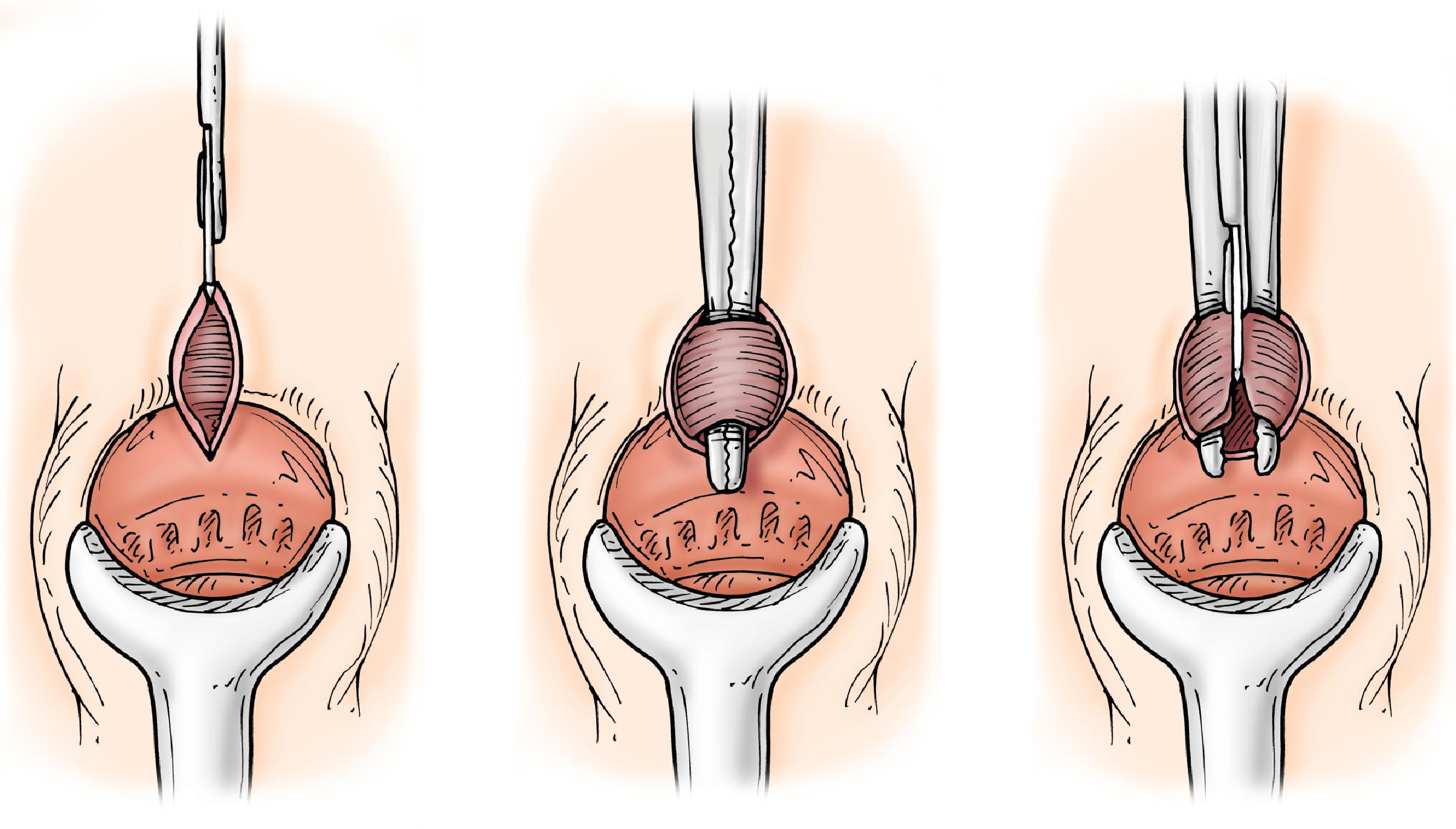
Our group favors the closed approach. In the closed approach, a blade is inserted in the intersphincteric groove parallel to the muscle fibers. The blade is then turned 90 degrees, and the IAS muscle fibers are divided against a finger inserted into the anal canal, without going through the mucosa. Manual spreading of the divide fibers in a gentle sweeping motion in the anal canal can confirm adequate division and separation ( Fig. 4 ). The cut typically includes all fibers below the dentate line.
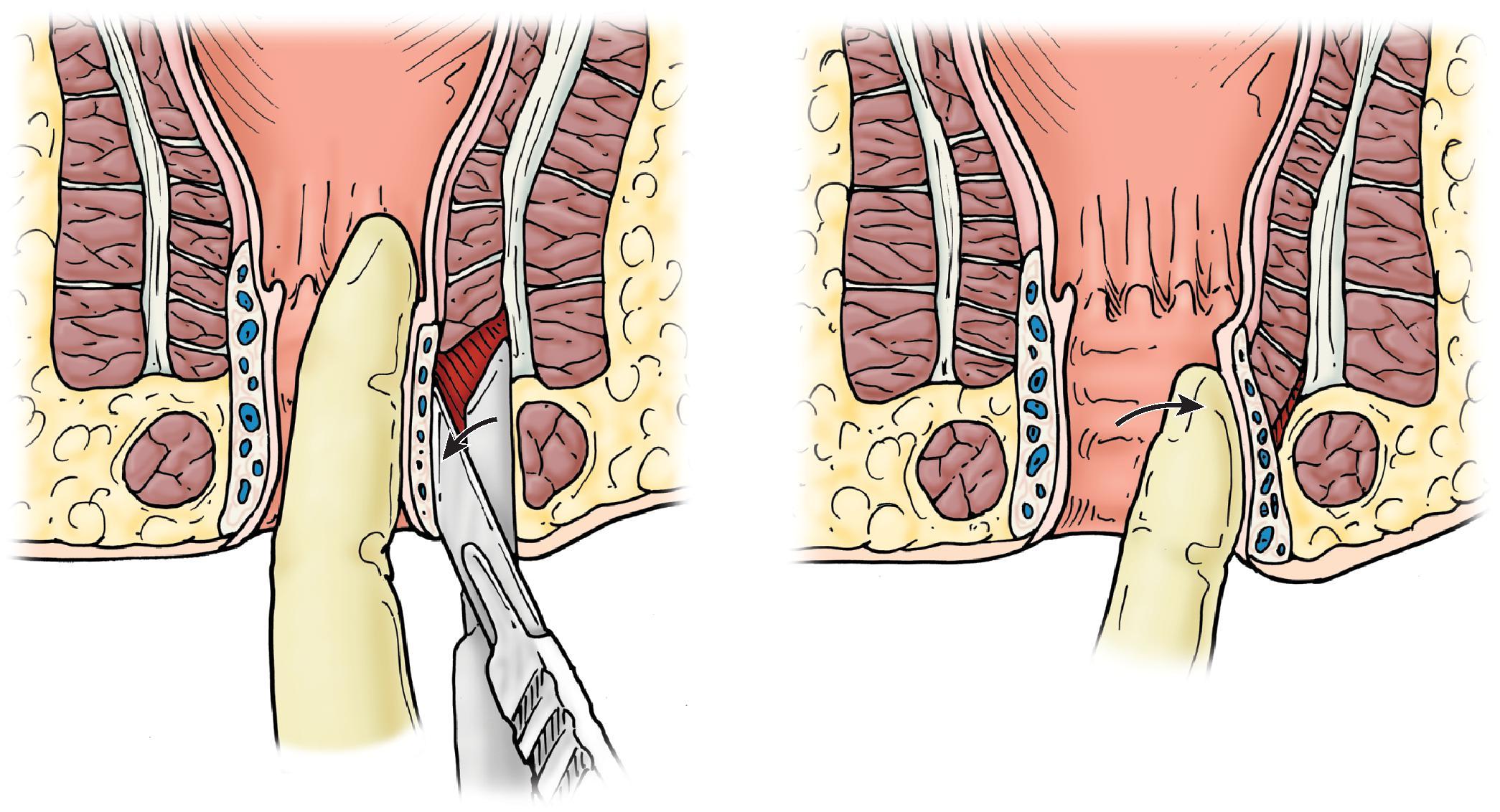
The overall rate of transient disturbed continence from a systematic review was 14% among over 4500 patients, with <1% reporting accidental defecation or stool seepage. Although there are some studies reporting higher rates of permanent incontinence following the open technique, results are inconsistent, and both open and closed sphincterotomies are well-accepted approaches.
To reduce the risk of incontinence, a tailored sphincterotomy has been proposed by dividing the IAS to the height/internal apex of the fissure, rather than the dentate line, which may result in excessive division. This approach should be considered in populations at higher risk for postoperative incontinence, including women who may have shorter anal canals and less muscle, multiple vaginal deliveries, or prior obstetric injuries; individuals with other sphincter or perineal injuries; and individuals with inflammatory bowel disease.
Patients with persistent or recurrent fissures after LIS are challenging to manage. Repeat LIS is not recommended given the high risk of permanent incontinence, especially in patients without increased sphincter tone. These patients without evidence of increased sphincter tone may benefit from a fissurectomy combined with a dermal advancement flap. Two common advancement flap techniques are the V-Y flap and house flap. A V-Y flap is created from the perianal skin, where the apex of the V is pulled proximally and sutured to the proximal apex of the fissure ( Fig. 5 ). In a house flap, the base of the pentagon-shaped flap is sutured to the proximal apex of the fissure, while the external “house roof” is closed linearly ( Fig. 6 ).
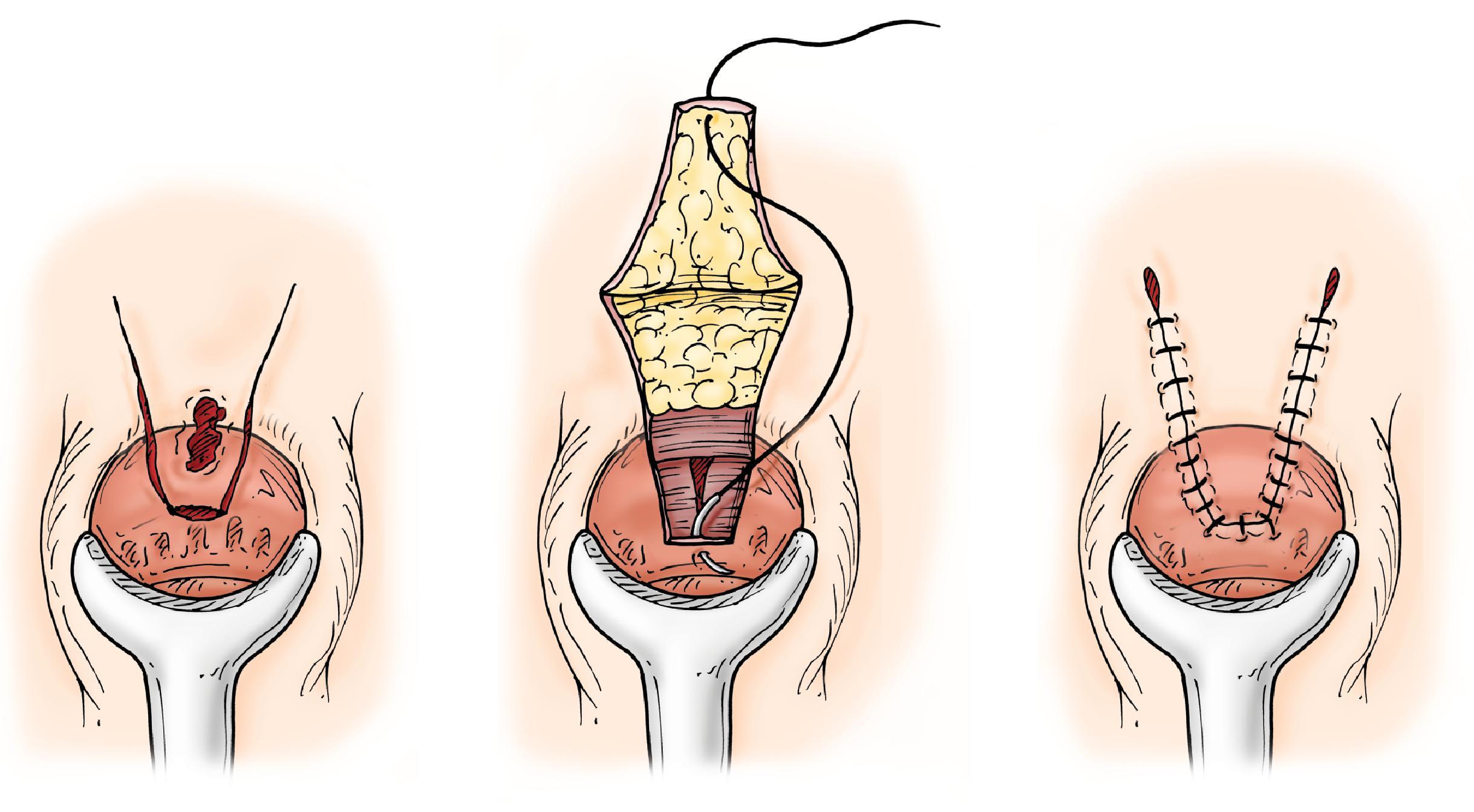
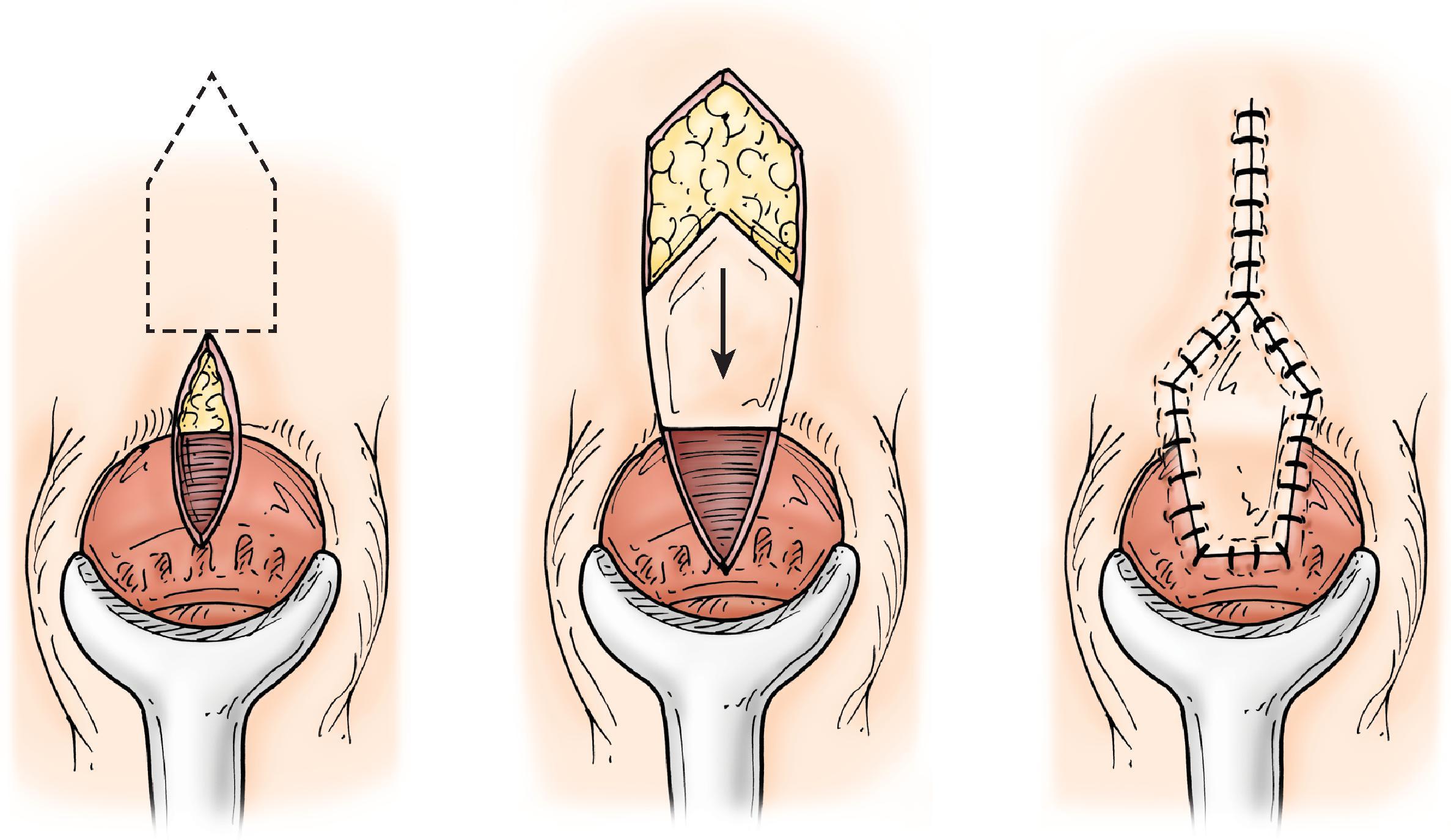
LIS for patients with preexisting fecal incontinence or risk factors should be offered cautiously so as not to worsen or permanently induce incontinence. These would include women with obstetric trauma or previous sphincter injuries.
When fissures are off midline, underlying disorders should be considered such as Crohn’s disease, human immunodeficiency virus (HIV), tuberculosis, anal cancer, sexually transmitted infections, or other immunosuppressive or infectious etiologies such as human papilloma virus (HPV) and syphilis. In such cases, biopsies and cultures are helpful for diagnosis. Patients who are immunocompromised secondary to chemotherapy will often present with diarrhea; nonoperative management and chemical denervation with Botox is recommended.
Perianal morbidity is a common phenotype of Crohn’s disease, and Crohn’s-related fissures generally should not be treated with sphincterotomy. Medical management directed at the patient’s Crohn’s disease will heal the majority of anal fissures. Patients who are constipated should be treated with fiber supplementation and increased hydration. Topical diltiazem and Botox denervation are recommended for nonoperative management, with early involvement of gastroenterology.
Approximately 100,000 patients in the United States will seek care for anorectal sepsis each year. The mean age of presentation is 40 years (range 20–60 years). Adult males are twice as likely to develop an anorectal abscess and/or fistula compared with females. Anorectal abscesses and fistulas can be thought of as two successive phases of the same infectious process, with an abscess representing the acute phase of infection and a fistula denoting the chronic phase of suppuration and fistulization. Thus it is not surprising that 30% to 70% of anorectal abscesses are associated with a concomitant anorectal fistula, and that 30% to 40% of patients develop an anorectal fistula after undergoing treatment for an anorectal abscess.
Management of anal abscess and fistula includes four basic principles: (1) control the septic process (drain the pus), (2) define the involved anatomy, (3) treat the underlying process without compromising sphincter function, and (4) minimize recurrence risk. Although many presentations are straightforward, complex and recurrent disease challenge even the most experienced surgeon. It is crucial for surgeons managing this disease to understand the regional anatomy, treat patients in the context of their comorbid conditions (such as Crohn’s disease), and apply the appropriate surgical technique. Improper management can lead to potentially life-threatening sepsis or significantly impact a patient’s quality of life by causing chronic discomfort and socially-inhibiting problems with personal hygiene.
The anal glands lie within the intersphincteric space and empty into the rectum through 10 to 15 crypts of Morgagni located circumferentially at the dentate line. When this drainage is blocked, pressure builds as the septic source grows and propagates along paths of least resistance within or through the intersphincteric space. The potential pathways of suppurative extension delineate the anatomic spaces of anorectal sepsis: intersphincteric, submucosal, perianal, ischiorectal, postanal (subdivided into superficial and deep by the anococcygeal ligament), and supralevator space ( Fig. 1 ).
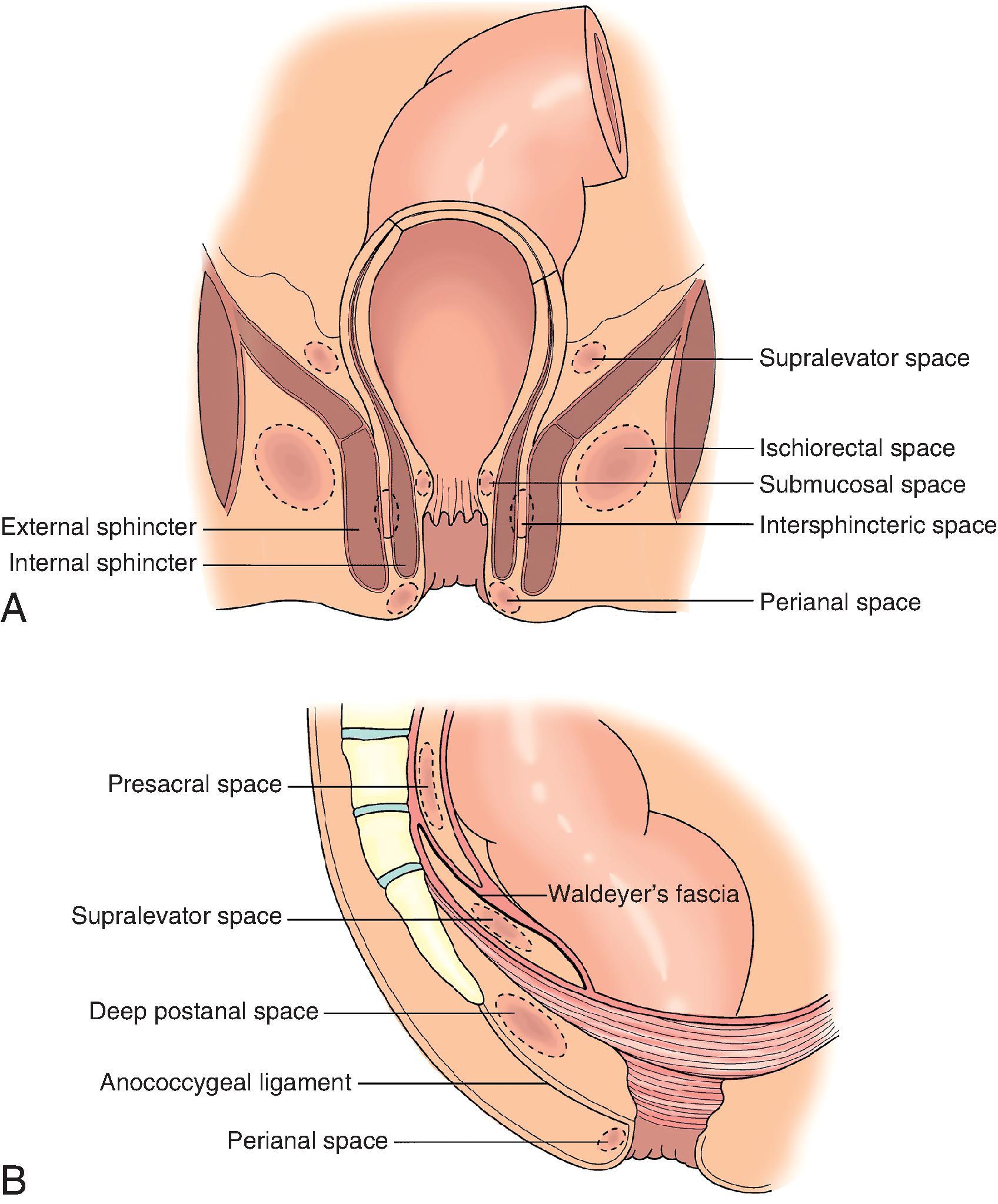
The intersphincteric abscess, located at the site of the anal glands, tracks craniocaudally between the sphincter layers. A submucosal abscess represents the least extensive suppurative process, located just beneath the mucosa above the dentate line. Perianal abscesses descend through the intersphincteric space to the subcutaneous tissue around the anus and below the sphincter complex. The ischiorectal space encircles the external sphincter caudad to the levator ani complex and medial to the ischial tuberosities; an ischiorectal abscess occurs from the extension of sepsis laterally from the intersphincteric space or caudally from the supralevator space. The postanal space is located posteriorly, between the levators (cranially) and the external sphincter (caudally); this space may be solely involved, or infection may extend laterally to the ischiorectal fossa, forming the so-called horseshoe abscess. The postanal space is divided into the superficial and deep postanal spaces by the presence of the anococcygeal ligament. Deep postanal space infections may be missed if this ligament is not penetrated during operative drainage. Supralevator abscesses, located above the levators as the name implies, are caused by cranial extension of cryptoglandular sepsis or by caudal extension of an intraabdominal process, such as diverticular disease, that perforates through the peritoneum.
Understanding the anatomic spaces of anorectal sepsis is imperative in deciphering the patient’s presentation and planning the appropriate intervention that attains adequate drainage and reduces complications such as systemic sepsis, recurrence, fecal incontinence, and complex fistula formation. Although the cryptoglandular theory is believed to be responsible for the vast majority of anorectal abscesses, it is crucial to identify contributing conditions or alternate causes such as those displayed in Box 1 . The impact of these factors and etiologies on the nature of the disease and treatment strategy will be discussed later in the chapter.
Cryptoglandular
Iatrogenic (anorectal or genitourinary surgery)
Perineal trauma
Radiation injury
Inflammatory bowel disease
Acquired immunodeficiency syndrome
Invasive fungal infection
Hidradenitis suppurativa
Diverticulitis
Anal fissure
Osteomyelitis
Foreign body
Malignancy (carcinoma, adenocarcinoma, hematologic malignancy)
Anal pain independent of defecation is the most common complaint, given almost one-half of anorectal abscesses are in the perianal space. Swelling and fever are often present. Associated symptoms or medical history suggestive of or including inflammatory bowel disease and immunocompromised status should also be gathered. On anorectal examination, an indurated bulge with fluctuance and cellulitis near the anal verge is indicative of perianal abscess. Intersphincteric abscesses are unique in their lack of external examination findings but cause exquisite tenderness on digital rectal examination. Ischiorectal abscesses typically have gluteal findings of induration, tenderness, and fluctuance several centimeters away from the anal verge without tenderness on digital rectal examination. Abscesses limited to the postanal space may have localized tenderness posterior to the anal verge, but without apparent induration or fluctuance. Induration or fluctuance between the posterior anorectum and coccyx will be noted on bimanual examination. Supralevator abscesses may have no anorectal findings unless there is a downward extension of sepsis into the ischiorectal fossa; fluctuance above the levators may be noted on digital rectal examination. Further evaluation with pelvic imaging should be considered to exclude their presence if a supralevator component is suspected. Anoscopy, rigid proctoscopy, and flexible sigmoidoscopy can be performed to evaluate the rectal mucosa for inflammatory bowel disease, but it is often not tolerated and should not be pressed. Patients who cannot tolerate an examination should undergo an examination under anesthesia (EUA).
The majority of patients with a suggestive history and physical examination can be managed with bedside drainage or operative evaluation and treatment. Radiologic imaging, however, is useful in some acute situations and helpful with more chronic or recurrent anorectal sepsis. CT is helpful in patients with associated abdominal symptoms or findings or with the clinical suspicion of a supralevator abscess. A pelvic CT scan should not be relied upon to exclude drainable anorectal infection; purulence can be present without definitive CT findings. Undrained anorectal infection can lead to severe systemic infection and destruction of the anal sphincter complex, resulting in functional morbidity. Endoanal ultrasound and MRI are not generally available or tolerated in the acute setting of anorectal abscess. Both, however, can be useful adjuncts in delineating the anatomy of complex, multiple, or recurrent fistula-in-ano.
Surgical drainage remains the definitive treatment of anorectal abscesses. Bedside drainage under local anesthesia using 1% lidocaine with dilute epinephrine is often well tolerated for perianal abscesses and small ischiorectal abscesses. After infiltrating the area with local anesthetic, a curved incision is made over the abscess. The incision should be oriented over the side of the abscess closest to the anal verge without transgression into the sphincter complex; this is done so if a fistula forms (an estimated 50% occurrence), it is more likely to have a simple, short tract. The temptation to drain an abscess over its most fluctuant point or at the furthest point from the verge should be avoided to prevent potential creation of a long fistula tract. A hemostat or finger is used to probe the wound, breaking down all loculations and defining the extent of disease. An ellipse of skin at least 1 cm in size incorporating the initial incision is excised to prevent premature closure of the skin. Hemostasis can be achieved with direct pressure, silver nitrate, or local anesthesia with epinephrine. The cavity is irrigated, and dry gauze is applied externally with the expectation of ongoing drainage. Packing the wound should be avoided because it subjects the patient to more pain and slower healing without the benefit of improved resolution of sepsis.
Large ischiorectal abscesses and those that must be approached transanally (intersphincteric, some supralevator, horseshoe, and deep postanal space infections) are most appropriately done in the operating room under monitored anesthesia care (MAC) or general anesthesia. A preoperative antibiotic with gram-negative coverage is administered. The anorectal region is best exposed with the patient in the prone jack-knife position and the buttocks taped widely apart, but the high lithotomy position is often adequate. A headlamp to improve visualization is recommended. Commonly used instruments include the Hill-Ferguson, Fansler, or Pratt bivalve retractors, fistula probes, curettes, 16- or 18-gauge angiocaths, and dilute hydrogen peroxide. The perianal region is inspected, noting any induration, fluctuance, or dermatologic abnormalities. A digital rectal examination is performed followed by anoscopy, looking for mucosal bulging, induration, sphincter defects, or other abnormalities. A biopsy should be performed on ulcerations, suspicious nodules, or perianal lesions to exclude neoplasia. A biopsy should be performed on recurrent abscess or fistula tracts as well in an effort to diagnose underlying inflammatory bowel disease, chronic infections (such as tuberculosis or actinomyces), or the rare malignancy. If the site of purulence is not obvious, an 18-gauge needle can be used to aspirate in suspected areas. Culture data is rarely helpful, but it may be so in patients with recurrent infections, nonhealing wounds, a history of methicillin-resistant Staphylococcus aureus, or underlying HIV infection in whom atypical microbes may be present.
For a large ischiorectal abscess, ipsilateral counterincisions can serve to establish adequate drainage rather than a large incision that resects overlying healthy tissue and prolongs healing unnecessarily. Digital exploration of the abscess cavity is prudent to ensure that extension into the postanal space or the contralateral fossa is not present. Packing is usually unnecessary and impractical for the patient to exchange. An alternate means of drainage utilizes a stab incision overlying the abscess, as close to the anal verge as possible, and the insertion of a 10- to 16-French mushroom catheter into the cavity. The catheter is secured with an anchoring suture and left in place for 1 week. The catheter is removed once a tract is well established, although it can be left in for prolonged periods in cases of large or recurrent infections.
Drainage of a postanal space abscess deserves special note. A radial incision is made from the posterior anal verge toward the coccyx. Subcutaneous tissue is divided, and the underlying fibers of the external sphincter are spread with a hemostat clamp. The anococcygeal ligament is then divided to access the postanal space. This fibrous ligament may take a bit of force to separate. A digit is inserted to explore the extent of suppuration. If a horseshoe abscess is present, elliptical counterincisions over the involved ischiorectal fossa are created. Penrose drains can be looped between incisions to maintain patency. If an underlying fistula is noted, a noncutting seton is placed to prevent recurrent sepsis ( Fig. 2 ). A second staged procedure to later address the fistula can be planned.

Intersphincteric abscesses are addressed transanally. The mucosa overlying the bulging/fluctuant anal canal is vertically divided with cautery. This exposes the underlying internal sphincter muscle with its circumferential transversely oriented muscle fibers. A fine-tipped hemostat is passed through the internal sphincter into the suppurative intersphincteric space and directed cephalad. The internal sphincter is divided over the hemostat with electrocautery. This generally does not compromise fecal continence, but patients should be informed of that small risk as part of informed consent. An alternative but less common method involves a stab incision at the anal verge in the intersphincteric groove and insertion of a small mushroom catheter into the affected intersphincteric space. The catheter is removed or backed out after sepsis has resolved.
The source of the supralevator abscess determines its treatment, which is why preoperative imaging can be helpful when a supralevator component is suspected. Descending abdominal or pelvic sources are typically addressed with CT-guided percutaneous drainage; more complex or severe intraabdominal disease may warrant transabdominal surgery or fecal diversion. Ascending cryptoglandular sepsis travels either through the intersphincteric space or through the levators from the ischiorectal fossa. The intersphincteric source is treated with transanal or transrectal drainage; incorrect surgical drainage through the ischiorectal fossa creates a suprasphincteric fistula. Conversely, the supralevator abscess with an ischiorectal source should be drained via skin incision to drain the ischiorectal fossa; transrectal drainage would be inappropriate and create an extrasphincteric fistula. A Malecot catheter may aid drainage of a supralevator abscess when accessed through the ischiorectal fossa ( Fig. 3 ).
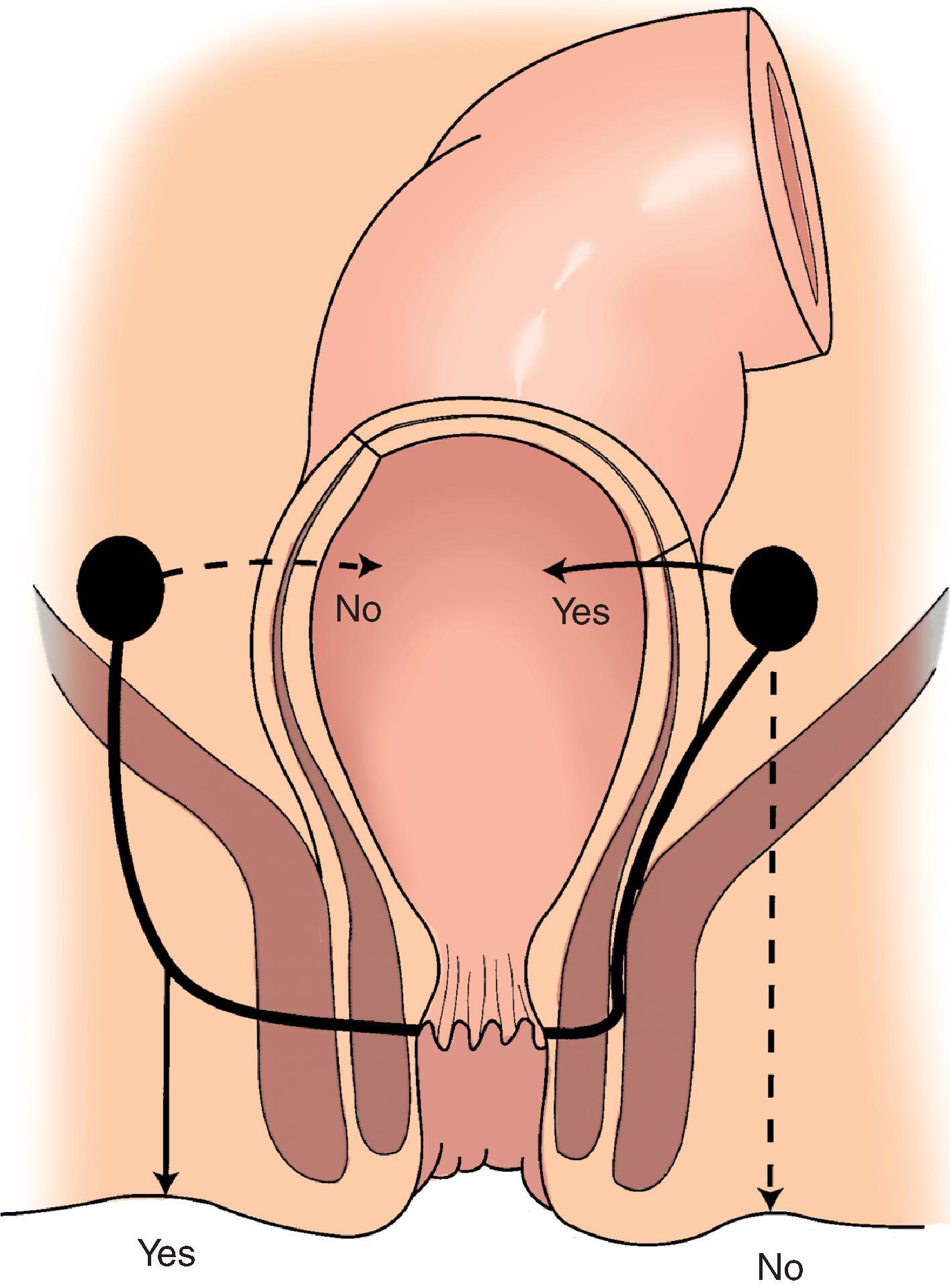
Fistulotomy at the time of incision and drainage of the anorectal abscess was once a contentious issue. Proponents argued that the presence of sepsis aided in defining the fistula tract; laying open the tract would reduce recurrence. Edema and inflammation from the suppurative process, however, may increase the risk of creating a false tract when probing and can make it difficult to accurately assess the degree of sphincter involvement. A general consensus has been reached, however, that primary or “prophylactic” fistulotomy submits a majority of patients who would never have recurred or developed a fistula to sphincterotomy and its attendant risks of fecal incontinence. Primary fistulotomy should only be selectively performed in the most straightforward of superficial or low transsphincteric fistulas, and provided that the anticipated benefit of healing outweighs the potential risk of fecal incontinence. Care must be taken to avoid creating false passages in the inflamed field while searching for the internal opening. Once the tract is cannulated with a fistula probe, the overlying tissue is divided and the wound is left open to drain. Primary fistulotomy is contraindicated in the elderly and in women with anterior fistulas, as well as in patients with compromised fecal continence, Crohn’s disease, AIDS, and high transsphincteric fistulas.
If a fistula is easily identified at the time of abscess drainage, an alternative treatment option is partial fistulotomy and seton placement. Although this commits the patient to a second-stage procedure, draining seton placement should prevent recurrent anorectal sepsis and, once healed, allow the surgeon to assess the patient’s anorectal function and tolerance of a second-stage fistulotomy or plan for a different fistula repair.
Most patients do not require antibiotic therapy after surgical drainage; antibiotics in general do not improve healing, reduce recurrence, or definitively decrease fistula formation after appropriate surgical drainage. In certain populations, however, antibiotics are warranted. Patients with large areas of cellulitis, signs of systemic sepsis or shock, prosthetic heart valves, or various conditions of immunocompromise warrant prolonged oral or parenteral antibiotics. Immunocompromised patient groups include those with diabetes mellitus, chronic corticosteroid use, acquired immunodeficiency syndrome, bone marrow transplant recipients, and active chemotherapy.
In contrast with all other patients with anorectal infection, profoundly neutropenic patients are often not addressed with surgery. The degree and duration of neutropenia is directly related to the incidence and prognosis of anorectal infections. In general, patient with absolute neutrophil counts (ANC) below 500 per cubic millimeter often do not mount sufficient immune response to develop suppuration. Therefore, patients with a low ANC and without fluctuance do not have a target for surgical drainage; prolonged, broad-spectrum antibiotics are recommended. Efforts to correct the neutropenia by holding chemotherapy and by administering neutrophil growth factors are employed. This vulnerable patient population must be monitored closely, given that a suppurative process may develop as the neutrophil count increases; imaging or EUA with aspiration may be useful adjuncts to identify a drainable source. Progressive sepsis, obvious fluctuance, or expanding soft tissue infection are indications for surgical evaluation, drainage, or debridement.
Necrotizing perianal skin infections are destructive, life-threatening infections that must be quickly differentiated from the more common anorectal abscess and infection on initial presentation because immediate surgical debridement offers the only chance at survival. Rapid development of severe anorectal pain that is out of proportion to findings on examination is the classic harbinger of a necrotizing infection. Risk factors include diabetes, chronic renal disease, obesity, smoking, underlying neurologic disease (such as dementia or spinal cord injury) that prevents early detection or communication of symptoms, and previous anorectal infections. Tender, irregular red, violaceous, or black macules and blisters in the perianal region are early signs of this dangerous process. These infections may be associated with crepitus, induration, or gangrene. Septic shock and electrolyte disturbances may develop. Anorectal sepsis with severe systemic manifestations should be quickly recognized and evaluated in the operating room; radical debridement of all nonviable tissue is necessary. Patients will require supportive management in the intensive care setting and empiric coverage with broad-spectrum antibiotics. Transfer to a tertiary center with hyperbaric oxygen capability should be considered if infection persists after initial debridement. By limiting the growth of anaerobic and other forms of bacteria and by boosting the effects of antibiotics and the immune system, hyperbaric oxygen is emerging as a powerful adjunct in treating this disease process and promoting healing. The need for fecal diversion is debatable and should only be considered in the subacute setting after hemodynamic stability is well established.
The cryptoglandular theory suggests that the acute suppurative process of anorectal sepsis originates at one of 8 to 10 anal glands located at the dentate line. These glands originate in the intersphincteric space and penetrate the internal sphincter with their ducts. They can become blocked and allow bacteria to cause infections which propagate along the path of least resistance until the growing pressure is released by surgical or spontaneous drainage. A fistula is the chronic sequelae of this process if the tract fails to heal and epithelializes. Although the cryptoglandular process is responsible for the vast majority of fistulas, other etiologies can instigate chronic inflammation and epithelialization along an abnormal communication between the skin and anorectum (see Box 1 ).
Although a perianal abscess is described by the anatomic space in which it forms, an anal fistula is most commonly classified in terms of its relationship to the internal and external anal sphincters. In 1976, Park et al. published the classification system that is used currently. Figure 4 depicts the four classes of fistulas. Each of these fistula classes can be further complicated by the presence of circular and/or high blind tracts that branch off the fistula tract into the intersphincteric space or ischiorectal fossa, but do not drain independently. Another type of fistula not included in the anorectal classification scheme is the superficial fistula, which is essentially a skin bridge with an underlying subcutaneous tract that does not involve the sphincter complex; this can be a result of scarring after recurrent infections and surgery, premature healing of an anal fissure, or another process, such as hidradenitis.
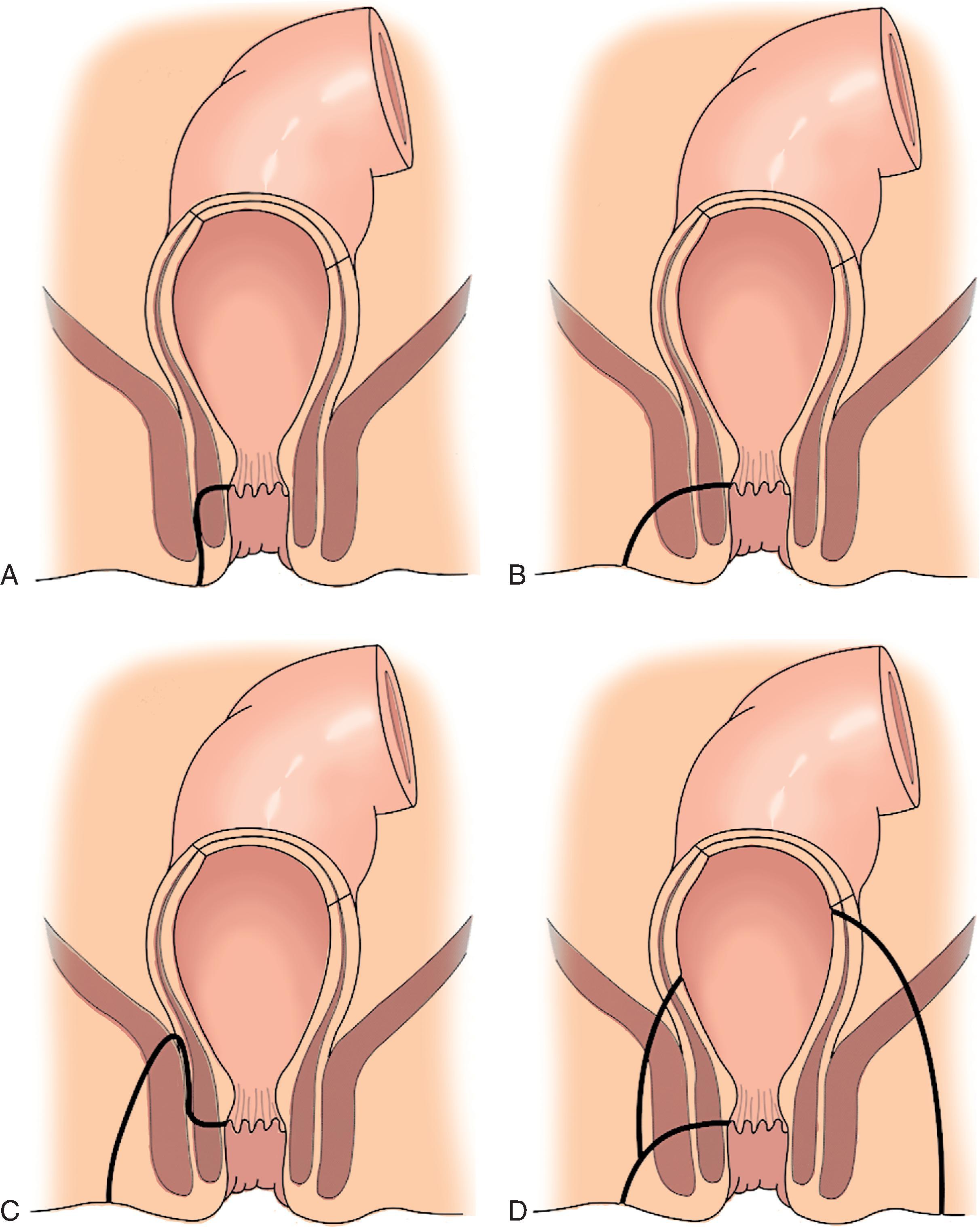
Fistulas can be further categorized as “simple” or “complex” fistulas. A complex fistula has features that increase the risk of recurrence and/or incontinence after intervention, either by its own anatomy or by patient factors. Table 1 defines features of complex fistulas, which includes most fistula classes except subcutaneous, intersphincteric, or low transsphincteric fistulas.
| Anatomy | Comorbid Conditions |
|---|---|
| Multiple fistulas | Compromised fecal continence |
| Suprasphincteric fistulas | Inflammatory bowel disease |
| Extrasphincteric fistulas | Refractory diarrhea |
| Associated high blind tract(s) | Anterior fistulas in women |
| High transsphincteric fistulas (>30% of anal sphincter length) | Immunodeficiency or compromised wound healing |
| History of regional radiationHistory of obstetric traumaElderly patientsPrior anorectal surgery |
Patients will frequently, although not always, have a history of a previous perianal abscess that spontaneously drained or required surgical intervention; patients may experience initial healing and have a recurrent abscess or other symptoms weeks, months, or even years after the index infection. Some patients will experience continual drainage and intermittent swelling months after recovering from an acute abscess, indicating a persistent tract from the internal opening to an either open or closed external opening.
Patients describe intermittent anal pain, pruritis, drainage that is mucoid, bloody, or feculent, or occasionally blood per rectum caused by friable granulation tissue at the internal opening. Cyclic discomfort and swelling that is relieved after spontaneous drainage is a common feature. Patients should be queried regarding gastrointestinal symptoms suggestive of inflammatory bowel disease and their current level of fecal continence. A history of anal surgery, anal infections, radiation, trauma, obstetric trauma, and systemic disease including inflammatory bowel disease, hematologic malignancy, or immunosuppression should be elicited, given these factors may affect continence and healing with many types of surgical interventions. On examination, the external opening is easily identifiable as an inflamed pyogenic granuloma; a palpable cord may be present and suggest the path of the tract. When less active, the external opening may be more subtle and appear more like a subtle dimple or scar. The internal opening can occasionally be palpated on digital rectal examination as a nodule or pit and is usually at the dentate line. Anoscopy, when tolerated, can assist in visualizing the internal opening as well as assess whether a distal proctitis is present. Further endoscopy can be considered in a patient with symptoms suggestive of inflammatory bowel disease.
Routine diagnostic imaging is typically unnecessary for patients with anal fistula, however imaging may be helpful in patients with a suspected occult anorectal abscess, recurrent or complex fistula, an unrevealing EUA, or suspected or confirmed anal Crohn’s disease. Preoperative endoanal ultrasound (EAUS) may help preserve anorectal function by measuring sphincter involvement; EAUS can successfully predict the amount of sphincter that would be divided if primary fistulotomy is performed as well as identify undrained sepsis, complex anatomy, and high blind tracts ( Fig. 5 ). MRI appears to have higher sensitivity in evaluating secondary extensions, suprasphincteric tracts, and extrasphincteric tracts in complex fistulas when compared to EAUS and has been shown to alter surgical approach and decrease recurrence rates. Transperineal ultrasound may be a lower-cost, less-invasive imaging option with similar diagnostic accuracy compared to EAUS and MRI, although it is less widely available. CT lacks adequate resolution to identify tracts and their relationship to the sphincters and levators with comparable accuracy. When imaging is indicated, the best option may be based on local radiologic expertise.
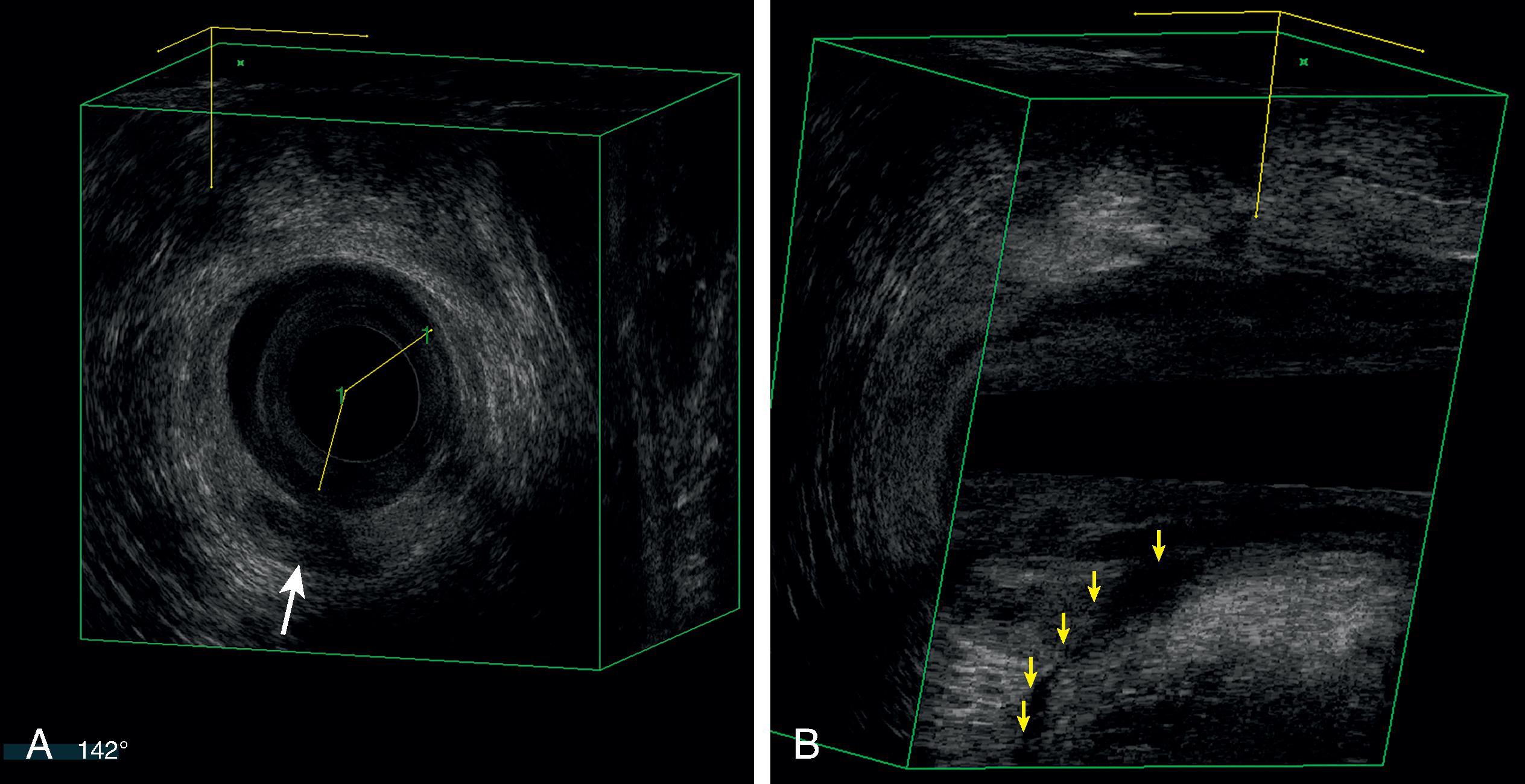
There are four tenets of fistula surgery: (1) define the fistula anatomy, (2) ensure the resolution of sepsis, (3) assess and preserve anal sphincter function, and (4) minimize recurrence risk. Maintaining these principles are critical at each step of treatment.
The anatomy of a fistula includes the internal and external openings, the course of the intervening tract(s), and the presence of any blind tracts or sinuses. The internal opening is described by its location and relationship to the dentate line, whereas tracts are delineated by their relationship with the sphincter complex and levators. Fistula anatomy can be estimated by office examination but is most definitively assessed in the operating room with an EUA. The patient may usually be consented for a definitive procedure, with the caveat that if a more complex fistula or unexpected findings are discovered during operative evaluation, a staged procedure may be required to preserve sphincter function and ensure successful surgical treatment. The patient is placed in the prone jack-knife position with the buttocks taped widely apart; some surgeons prefer high lithotomy or left lateral positioning. The perianal region is inspected, identifying evident external openings, suspicious lesions, or scars, which can be probed. Goodsall’s rule predicts that an external opening posterior to a transverse line across the anus drains to a posterior midline internal opening, while those that open anterior to the line have short, radial courses to the internal opening. Although Goodsall’s rule is accurate for a majority of the posterior external openings, it has been shown to be less accurate in women with anterior openings.
Digital rectal examination is performed to assess for undrained sepsis and location of the internal opening. Anoscopy is used to identify the internal opening and to note any signs of proctitis or malignancy. A fistula probe is inserted into the external opening and gently advanced toward the anticipated internal opening with subtle redirection as resistance dictates. The fistula tract should easily accept the probe without the sensation of tissue destruction; a false tract must not be created as it will only serve to complicate the disease and neglect the primary tract. The internal opening may also be identified by injecting dilute hydrogen peroxide into the external opening with an angiocatheter. If the internal opening is not easily identified, the surgeon should not persist to find or create one. Once the internal and external openings are identified, the tract can be cannulated with the fistula probe; if the tract is not cannulated fully, the tract may be curved. Curving the fistula probe or straightening the tract with a Kocher clamp may facilitate cannulation. Once cannulated, the type of fistula is established by determining its relationship to the internal and external sphincter complex, the levators, and presence of multiple fistulas or blind tracts. The percentage of sphincter complex caudal to the tract is determined by palpating the apex of the sphincter complex in relationship to the probe. Low transsphincteric fistulas are defined as those that involve less than 30% of the external sphincter complex.
If the tract cannot be fully cannulated, the external opening is enlarged toward the anal verge, a curette is used to debride the tract, and the operation is terminated. This approach may be associated with a higher risk of recurrence but avoids creating an iatrogenic false internal opening at a false location. Adjunctive imaging with ultrasound or MRI to better identify fistula anatomy is performed after 3 to 6 weeks to allow for inflammation related to surgery to subside.
For many patients with complex fistulas or an obvious fistula at the time of operative treatment of anorectal sepsis, a conservative, staged approach with the initial placement of a seton is most appropriate. This allows the possibility of multiple options to treat the fistula in the future without compromising sphincter integrity.
For a patient treated initially with a seton, a second-stage procedure can be considered when the internal opening is less than 5 mm and the tract is simple, narrow, and without an associated cavity. Ongoing sepsis, as evidenced by pus, cellulitis, induration, or a persistent cavity, prevents healing and closure of the tract; any efforts to close the fistula definitively will likely fail. In the setting of persistent infection, a fistulotomy can be performed only in a simple intersphincteric or low transsphincteric fistula to simultaneously address the sepsis and the fistula. Complex fistulas with persistent sepsis should be considered to have an undrained source of infection. They can be addressed with debridement of the tract around the seton, widening of the external opening, and a search for a high blind or circular tract. If additional treatable sources of the persistent sepsis cannot be identified or sepsis continues despite these approaches, imaging is pursued.
Although a controlled anal fistula with or without a seton can cause significant discomfort and problems with personal hygiene, fecal incontinence is far more disruptive to a patient’s quality of life. For that reason, preservation of continence is always a priority when choosing the proper management strategy. Division of the internal sphincter is usually well tolerated without much effect on continence, especially in men. Division of the distal third of the external sphincter is considered “safe” in healthy male individuals; this can be considered in the posterior external sphincter in women without preexisting sphincter dysfunction. The degree of sphincterotomy tolerated without affecting continence is undoubtedly patient-dependent. Careful analysis of a patient’s risk for incontinence includes an assessment of their current degree of continence, prior anorectal surgery, trauma, and obstetric history as well as associated conditions that may cause diarrhea or inhibit healing. Women in particular are vulnerable to incontinence as a result of a shorter sphincter complex, anatomic and neurologic injury to the pelvic floor sustained during childbirth, and loss of elasticity and muscle attenuation associated with aging and menopause. Patients with active inflammatory bowel disease involving the anorectum and immunodeficiencies often heal poorly and suffer recurrent or metachronous fistula disease. Sphincter-preserving techniques are preferred in these patient populations. Table 2 provides a guide to choosing the proper surgical technique, although it does not take into account relevant patient factors.
| Type of Fistula | Fistulotomy | Seton * | LIFT | Advancement Flap | Fibrin Glue | Collagen Plug | Address Intraabdominal or Pelvic Source |
|---|---|---|---|---|---|---|---|
| Superficial/intersphincteric | X | ||||||
| Low transsphincteric | X | X | X | X | X | X | |
| High transsphincteric | X | X | X | X | X | ||
| Suprasphincteric | X | X | X | X | |||
| Extrasphincteric | X | X | |||||
* Seton placement can be a first stage or definitive treatment option.
Complex fistulas are a frustrating disease process because they are prone to recurrence despite meticulous surgical technique. Although primary fistulotomy has the lowest recurrence risk, it also is associated with the highest risk of incontinence because of inherent disruption in the sphincter complex. All other sphincter surgical procedures, although they preserve the muscular anatomy, are associated with much higher recurrence risk. This must be considered in an informed consent discussion with patients. Reported outcomes in many of these described procedures vary widely; a surgeon’s personal experience with a procedure may be the most important factor in reducing recurrence.
Fistulotomy can be done at the time of abscess presentation, at the time of initial fistula presentation, or as a second-stage procedure in appropriately selected patients. Regardless of timing, a fistulotomy is only appropriate in low-risk patients with a superficial, intersphincteric, or low transsphincteric fistula. Once the anatomy of the fistula is determined, the tract is cannulated and the tissue overlying the probe is divided with electrocautery. The tract is debrided with a curette to remove debris and granulation tissue. The deepithelialized wound, now effectively a ditch instead of a tunnel, is allowed to heal by secondary intention.
For larger wounds, wound healing can be accelerated and bleeding avoided by marsupialization of the wound; this is performed by sewing the wound edges to the base of the wound with a continuous locking absorbable suture. Marsupialization can prevent both the premature epithelization of the wound edges before the deeper base heals and the subsequent formation of a subcutaneous fistula.
Sphincter-sacrificing procedures have the highest success rates, generally over 90%, but are also associated with some degree of fecal incontinence in up to 40% of patients in some series. Hence fistulotomy is usually not appropriate for high or complex fistulas. Factors related to recurrence after fistulotomy include branching of fistulas, failure to accurately identify the internal opening, and fistulas associated with Crohn’s disease.
A noncutting seton allows for ongoing drainage of sepsis and promotes fibrosis and maturation of the fistula tract as well as resolution of any abscess cavity, often in preparation for a second-stage procedure. After the fistula tract has been defined and debrided, the external opening is opened slightly toward the anal verge. Circular, high blind tracts, and long subcutaneous tracts are appropriately laid open or drained and curetted. A thin silastic band, vessel loop, or nonabsorbable suture is threaded through the tract and secured in a loop or omega shape with several interrupted silk sutures. The seton should not be tight; a hemostat should easily fit between the skin and loop without tension. The second-stage procedure, either fistulotomy or a sphincter-preserving operation, is usually performed 6 to 10 weeks later, although a waiting period of 3 to 4 months is advised for more complex fistulas and abscess cavities. Setons used in this fashion for complex fistulas have success rates of 62% to 100%, depending on patient factors and the choice of the secondary procedure. For some Crohn’s or other high-risk patients, seton placement can be the definitive operation; it is left in place for prolonged periods (years) to prevent recurrent sepsis without the intention to perform a second-stage procedure due to the likelihood of failure or iatrogenic incontinence.
In rare situations, a seton can be used to perform a slow, controlled fistulotomy in complex fistulas. Historically, a cutting seton was used when the risk of incontinence from a traditional fistulotomy was considered to be too high. The cutting seton is tightened at interval office visits to gradually divide the fistula and involved sphincter muscle. Cutting setons have high success rates in resolving anal fistulas, however some studies report some level of impaired continence in up to 67% of treated patients. Hence cutting setons should be used very selectively.
Ligation of the intersphincteric fistula tract (LIFT) is a relatively new sphincter-preserving technique first described in 2007. This procedure is most often performed as a second-stage procedure for a transsphincteric fistula after a mature tract has developed. A draining seton may be used before the LIFT procedure to allow for fibrosis of the tract, but this has not been clearly shown to affect the success rate of the LIFT procedure.
With the patient in the prone jack-knife position with the buttocks taped widely apart, the fistula tract is cannulated with a probe. The external opening is widened to allow for drainage ( Fig. 6 ). A 1- to 2-cm curvilinear incision is made with electrocautery over the palpated intersphincteric groove superficial/distal to the fistula tract. A Lonestar retractor (CooperSurgical) deployed along the anoderm edges provides excellent exposure. The intersphincteric plane is bluntly developed with a fine-tipped hemostat. The fistula tract is circumferentially isolated with care to avoid disrupting it. The probe is removed, and both distal and proximal ends of the intersphincteric tract are suture-ligated with 3-0 absorbable suture. The tract is sharply divided with a scalpel. The external opening is injected with hydrogen peroxide; if there is a persistent leak, the intersphincteric opening of the external sphincter is oversewn until there is no longer a leak. Some authors test the internal opening with peroxide as well to ensure proper closure of the proximal portion of the tract. The anoderm is reapproximated with a running absorbable suture. Very high fistula tracts or those that track long distances within the intersphincteric space may be difficult to properly isolate in the intersphincteric plane and not good candidates for this approach.
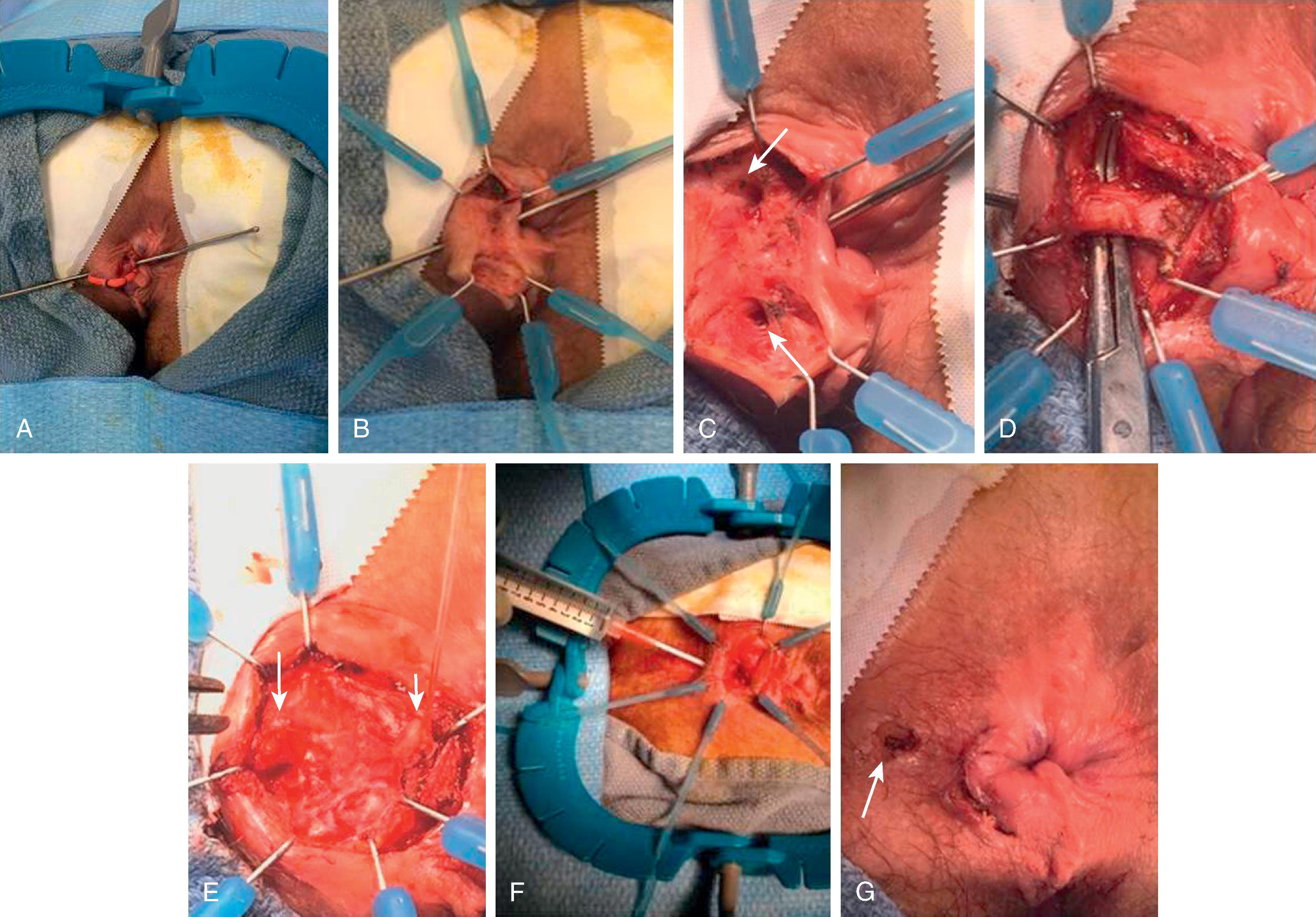
A meta-analysis of 1378 LIFT procedures from 26 studies demonstrated an overall success rate of 76%, an overall complication rate of 14%, and a low rate of fecal incontinence of 1.4%. Horseshoe anatomy, Crohn’s disease, and prior fistula surgery were risk factors for failure. Some failures result in resolution of the external sphincter involvement, converting the fistula to a simple intersphincteric fistula that is more amenable to fistulotomy. Because of this, secondary healing after surgical reintervention can be as high as 77% to 86%.
The endorectal advancement flap is a sphincter-preserving operation used as a second-stage procedure for high fistula tracts, suprasphincteric tracts, and low tracts in high-risk patients with healthy rectal mucosa (see Table 1 ). For lesions below the dentate line, fistulotomy or a dermal advancement flap is preferred to prevent the creation of a mucosal ectropion that can form if the rectal mucosa is brought down to near the anal verge. Patients may undergo a preoperative bowel preparation. Performed under general anesthesia, the prone jack-knife position is preferred for most fistulas, although the lithotomy position is often used to address posterior midline internal openings. The seton is removed, and the internal opening serves to mark the apex of the flap ( Fig. 7 ). Beginning at the internal opening, a flap is created by distal-to-proximal dissection with electrocautery including mucosa, submucosa, and a few fibers of the internal sphincter (partial thickness). To ensure adequate perfusion, it is crucial that the base (proximal end) of the flap is wide, at least two to three times the width of the apex. The trapezoidal-shaped flap is typically 2 to 4 cm long to allow for tension-free closure caudal to the level of the original internal opening. Care should be taken to avoid excessive handling of the flap, which can result in hematoma formation and tissue compromise. The fistula tract is debrided with a curette, and the external opening is widened to allow for drainage. Absorbable suture is used to close the internal opening, and the integrity of the closure is tested with injection of hydrogen peroxide at the external opening. The tip of the flap with the internal opening is excised, and the flap is gently pulled distally over the internal opening to the dentate line, but not below it, to prevent ectropion formation. Wound edges are reapproximated with interrupted absorbable suture.
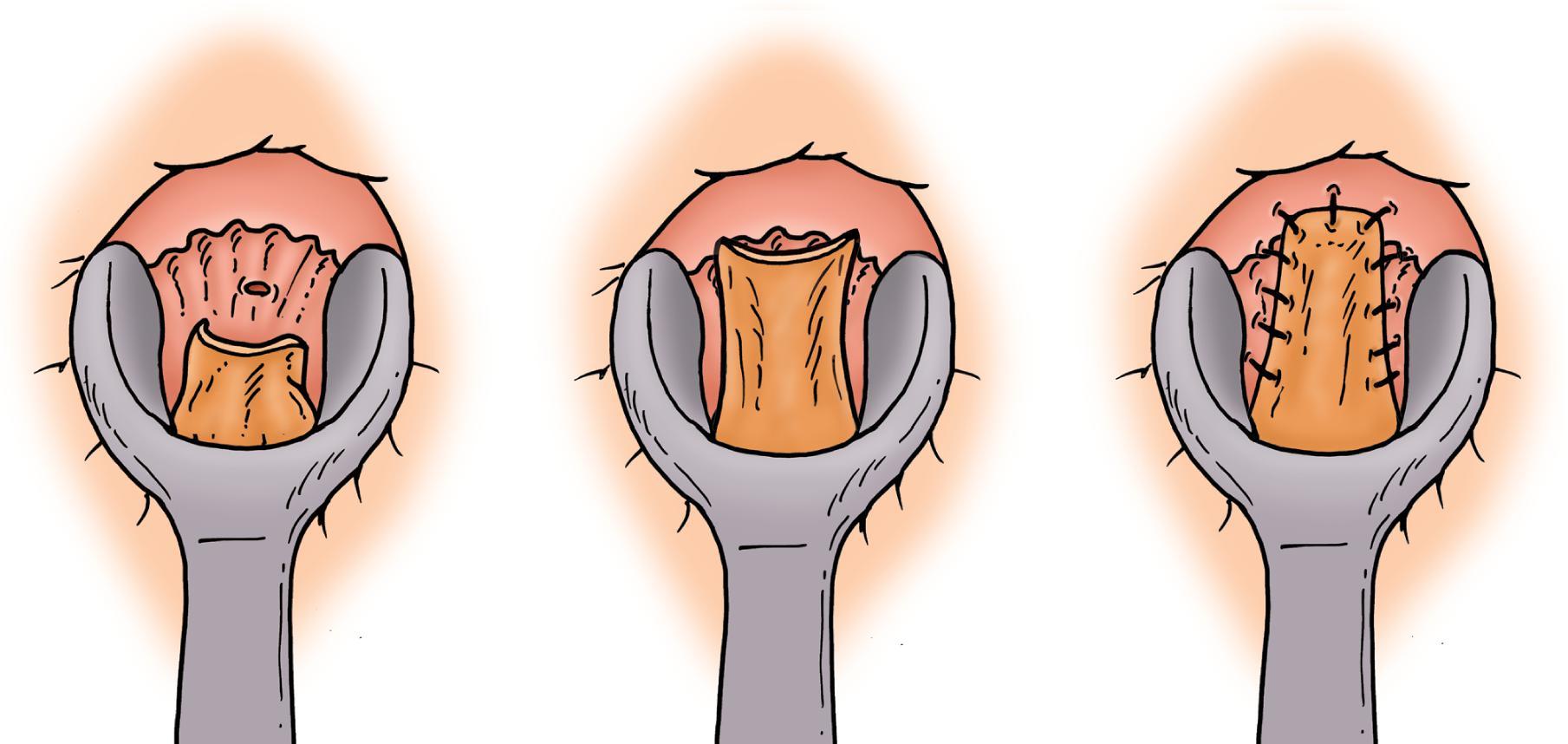
Fistula healing after endorectal advancement flap repair is reported in 66% to 87% of patients with cryptoglandular disease. Factors associated with failure include prior radiation, Crohn’s disease, active proctitis, prior abscess drainage, rectovaginal fistula, smoking, malignancy, obesity, and having more than one prior attempted fistula repair. An endorectal advancement flap may be repeated after a failed flap procedure or performed after other failed approaches including LIFT, with healing rates that range between 57% and 100%. Changes in bowel continence have been reported in up to 35% of patients treated with the procedure.
Synthetic and biologic materials such as fibrin glue and fistula plugs were once promising additions to the armamentarium of fistula treatment. Their general principle is obliteration of the internal opening and fistula tract. Their primary benefit was a minimal risk profile, as they pose no risk to continence, are easily repeated in the case of recurrence, and do not preclude subsequent surgical management. However, more recent evaluations reveal low success rates, so the procedures as standalone procedures have been relatively abandoned. The use of fistula plugs or biologic mesh has been described to augment the success of the LIFT repair however evidence that this leads to superior results is limited.
Minimally invasive approaches to anal fistulas that use endoscopic or laser closure techniques such as video-assisted anal fistula treatment (VAAFT), fistula laser closure (FiLaC), and endoscopic clipping using an over-the-scope clip (OTSC) device have been described in small, single-institution series with limited follow-up and various degrees of industry support. Although short-term healing appears comparable to LIFT and endorectal advancement flap repairs, long-term results are unavailable. All of these techniques require specialized equipment and expertise, and their use is generally not recommended at this time.
Anal stenosis is a narrowing of the anal canal. The narrowing can be anatomic, in which normally pliable anal mucosa is replaced with fibrotic tissue. This scarring can be isolated or circumferential and can vary in length. The narrowing can also be functional as a result of a hypertonic internal sphincter. The causes of anatomic stenosis can be further subdivided into congenital, primary, and secondary causes ( Box 1 ). The most common cause of secondary stenosis is surgery, most likely occurring after multiquadrant hemorrhoidectomy when large areas of anoderm are removed. The literature cites that up to 87% of cases are secondary to hemorrhoidectomy (Liberman & Thorson, 2000; Katdare & Ricciardi, 2010; Khubchandani, 1994). Stenosis may also result after procedures such as low anorectal anastomosis or fistulectomy (Chiarelli et al., 2018). This chapter focuses on the diagnosis and management of anatomic secondary anal stenosis.
The diagnosis of anal stenosis is largely clinical, taking into consideration the patient’s surgical and medical history as well as physical examination findings. The patient will often present with complaints such as constipation, obstipation, painful bowel movements, bleeding, and small-caliber stools (Farid et al., 2010; Chiarelli et al., 2018). Alternatively, they can have diarrhea caused by chronic laxative use or overflow from subsequent upstream rectal dilation. It is recommended that an anorectal examination be performed under anesthesia to both minimize patient discomfort as well as distinguish between a functional and anatomic cause of stenosis. Under anesthesia, the internal sphincter will relax, leading to resolution of the stenosis if it is functional. With true scarring and stricture, the stenosis will remain regardless of muscle relaxation. Anoscopy and proctoscopy can be useful in determining the extent of stenosis and assess the health of the rectal mucosa (Liberman & Thorson, 2000; Katdare & Ricciardi, 2010). It is important to look for any firm tissue, ulcerations, or outgrowths within or surrounding the area of stenosis and biopsy when appropriate to rule out malignancy as a cause. Grading of anal stenosis proposed by Milson and Mazier is based on severity and level of involvement within the anal canal ( Table 1 ). This classification may help guide the next steps in management (Milsom & Mazier, 1986).
| Severity | Level of Stenosis |
|---|---|
| Mild: Anal canal can be examined by a lubricated index finger or medium Hill-Ferguson retractor. | Low: Involvement at least 0.5 cm distal to the dentate line |
| Moderate: Forceful dilation is required to insert a lubricated index finger or medium Hill-Ferguson retractor. | Middle: Involvement 0.5 cm distal and proximal to the dentate line |
| Severe: Forceful dilation is required to insert a lubricated little finger or small Hill-Ferguson retractor. | High: Involvement 0.5 cm above the dentate line |
Management of anal stenosis depends on severity of stenosis and the patient’s symptoms. It is generally accepted to start with conservative measures. This involves management with a high-fiber diet, adequate hydration, and stool softeners. In addition, gradual manual anal dilation can be performed. The initial dilation can be performed under anesthesia with subsequent serial dilation done by the patient at home with a finger or a small plastic dilator. Dilation may be considered controversial given the risk of incontinence, as it may lead to hematoma formation within the intersphincteric space causing further scarring (Khubchandani, 1994). Although there are associated risks, some patients respond well to dilation. It should be considered particularly in cases of Crohn’s disease and radiation therapy where large perineal surgical operations are not advised (Kashkooli et al., 2015; Liberman & Thorson, 2000; Lightner et al., 2020). Most cases of mild and moderate stenosis can be managed conservatively. For cases of severe stenosis, it is still recommended to begin with medical management, although patients are likely to require surgery (Brisinda et al., 2009).
Surgical management is considered in cases of moderate to severe stenosis or for those patients who failed medical management. There is a wide variety of options for surgical management. In cases of anastomotic stricture, a step-up approach should be considered. Initially, dilation can be performed, followed by circular stapler resection or stricturoplasty, and then finally transabdominal resection of the anastomosis with repeat anastomosis as the last option (Kraenzler et al., 2017). For other anatomic strictures, anoplasty is the treatment of choice. The overall goal of anoplasty is to divide the stricture and deliver more pliable, healthy anoderm into the area without tension, thereby relieving the stenosis. This can be done with a variety of surgical techniques.
Stricturoplasty involves release of the stricture. The stricture is divided longitudinally and closed transversely. This method can provide symptom relief for the patient but can lead to subsequent scarring and recurrent stenosis (Duieb et al., 2009; Katdare & Ricciardi, 2010).
During mucosal advancement flaps, the scar is excised and if there is also scarring of the underlying sphincter, a sphincterotomy is performed ( Fig. 1 ). A transverse incision is made at the dentate line, and the rectal mucosa is undermined and advanced to the distal edge of the internal sphincter to cover the defect (Rakhmanine et al., 2002). The external portion of the wound is left open. Although there is a small risk of mucosal ectropion, this is a good option for midlevel stenosis because of minimal complications and symptom relief (Casadesus et al., 2007).
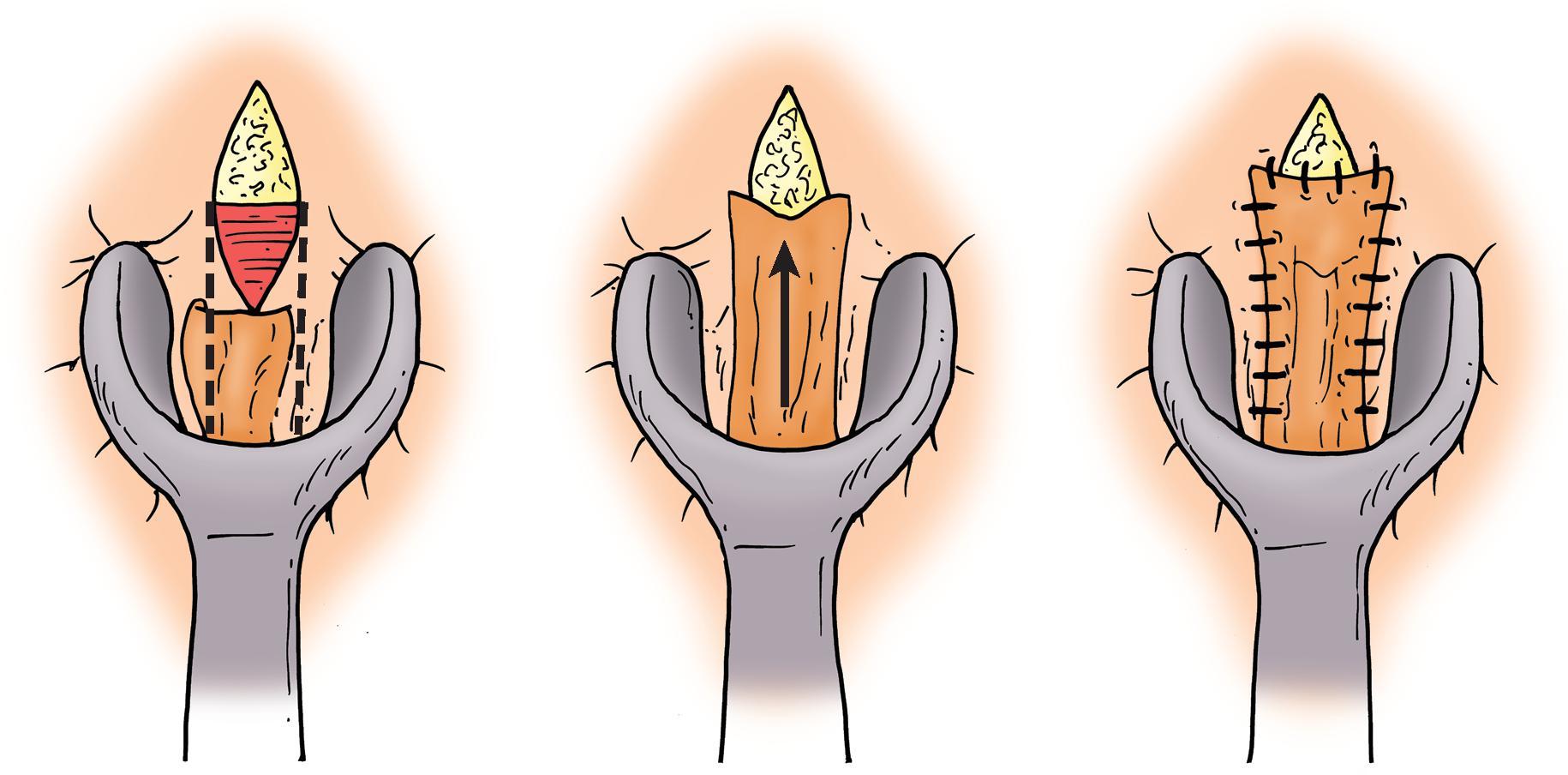
This technique begins with a Y - shaped incision at the area of stricture, and then it is carried on to the perianal skin, creating a V ( Fig. 2 ). The V portion of the incision is taken down to the subcutaneous tissue, which contains the blood supply to the flap (Gingold & Arvanitis, 1986; Liberman & Thorson, 2000). The apex of the V is advanced into the anal canal and affixed to the internal sphincter and rectal mucosa. This technique can be done bilaterally but is not considered adequate for coverage of a stenosis >25% circumference of the anal canal (Brisinda et al., 2009).
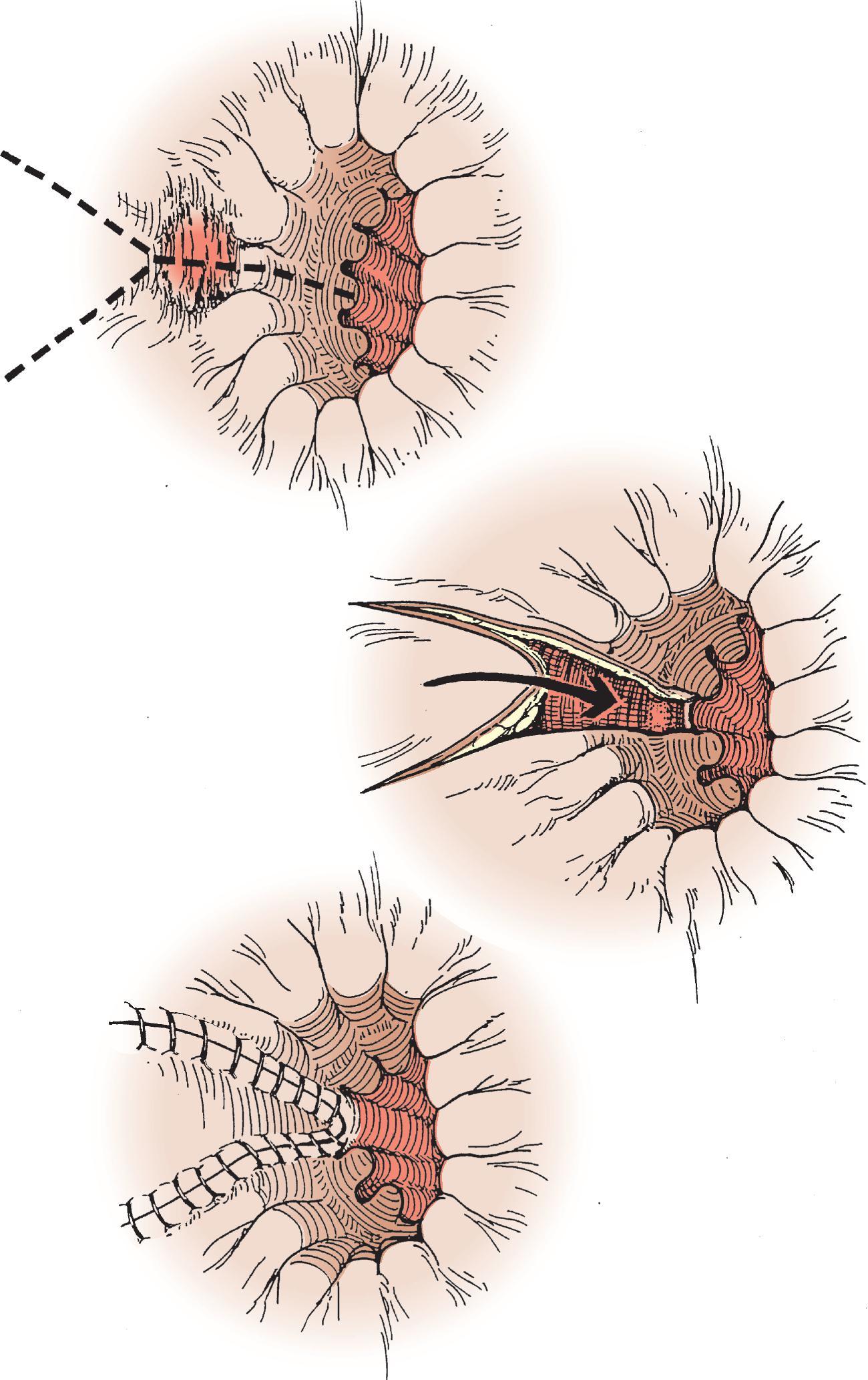
An initial vertical incision is created to incise the scar tissue ( Fig. 3 ). A V - shaped incision is then made with the apex lying on the perianal skin. Similar to the Y-V flap, the V is carried down to the subcutaneous tissue. The broad-based portion is advanced and affixed to the dentate line with the final Y - shaped incision. This technique is useful for the management of low, severe anal stenosis (Angelchik et al., 1993).
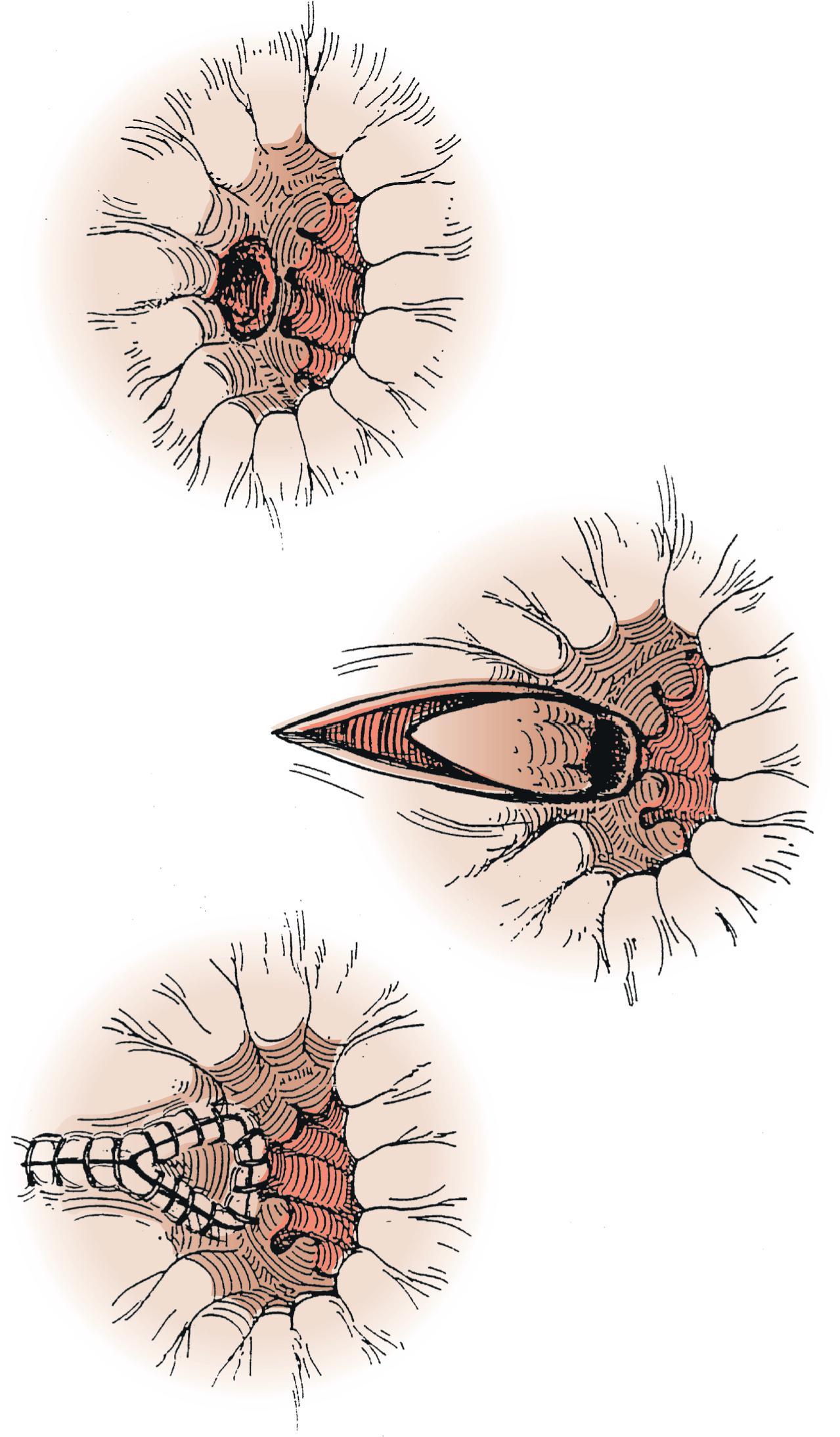
The initial incision is longitudinal and created from the dentate line to the area of stenosis ( Fig. 4 ). Two transverse incisions of equal width are then created on both ends of the longitudinal incision. A house-shaped flap is then created with the width of the base matching the width of the transverse incisions and is carried down to subcutaneous tissue with the apex overlying the perianal skin. It is then advanced into the anal canal to cover the defect and sutured in place (Christensen et al., 1992). This technique is useful for stenoses that extend from the dentate line onto perianal skin. It also avoids the narrow apex involved in Y-V advancement flaps, which are subject to ischemia (Alver et al., 2008; Casadesus et al., 2007). House flaps can be performed bilaterally and cover large areas of stenosis (Chiarelli et al., 2018).

For a diamond-shaped flap, the scar is incised with a vertical incision that is carried on to perianal skin to make a diamond shape ( Fig. 5 ). The flap is advanced into the anal canal and sutured (Liberman & Thorson, 2000). The U - shaped flap is performed in similar fashion ( Fig. 6 ). It is useful for management of strictures with associated mucosal ectropion, but the donor site is not closed, making it a less desirable technique (Brisinda et al., 2009).
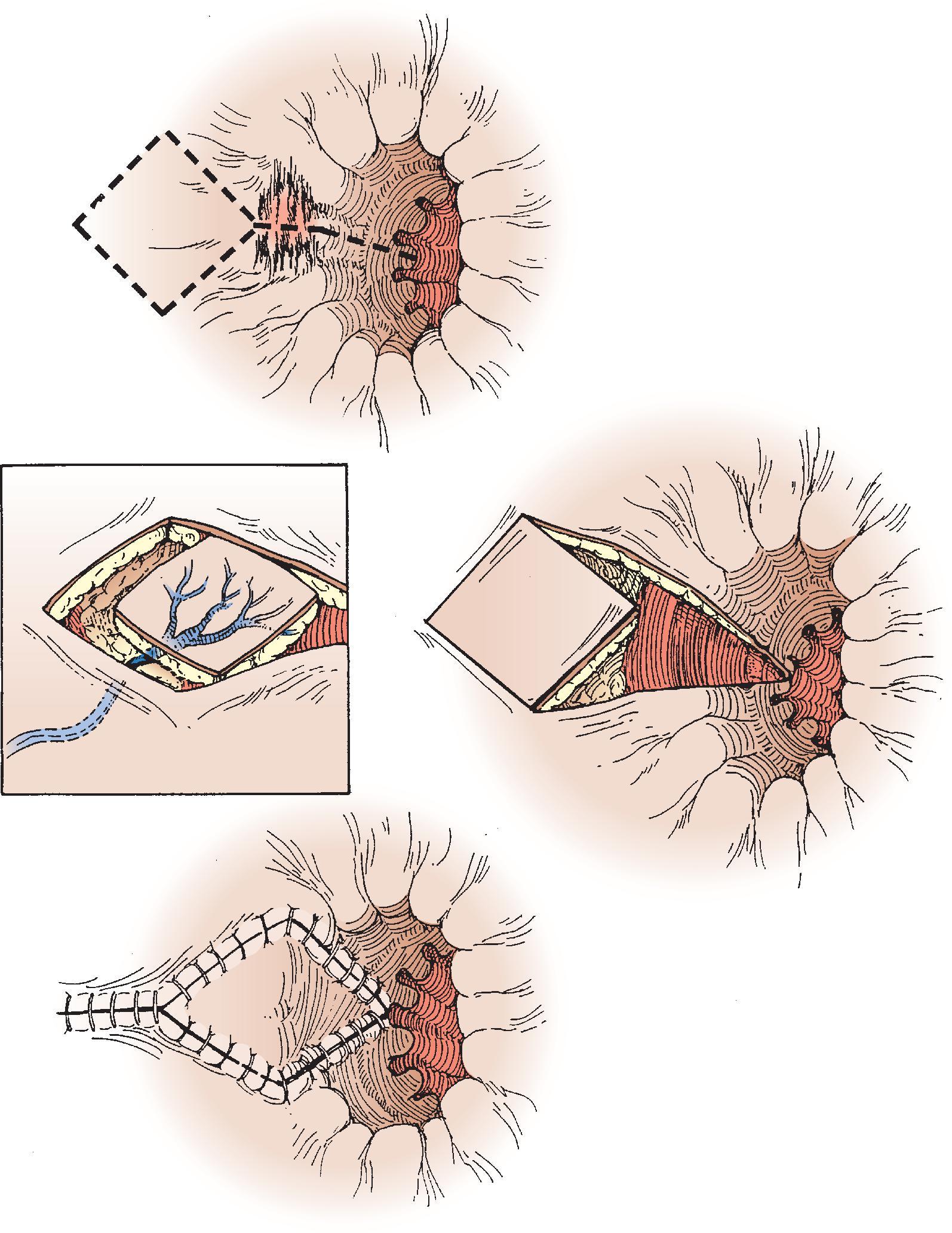

This technique is used is cases of extensive and circumferential anal stenosis that require excision of a large amount of skin (Handaya & Sunardi, 2019) . An S - shaped incision is created, with the midportion carried down to the dentate line transversely ( Fig. 7 ). The wide portions of the S are then rotated down to the dentate line and sutured. One limitation of the S flap is that it does not release the stricture as effectively as the previously described advancement flaps (Brisinda et al., 2009).
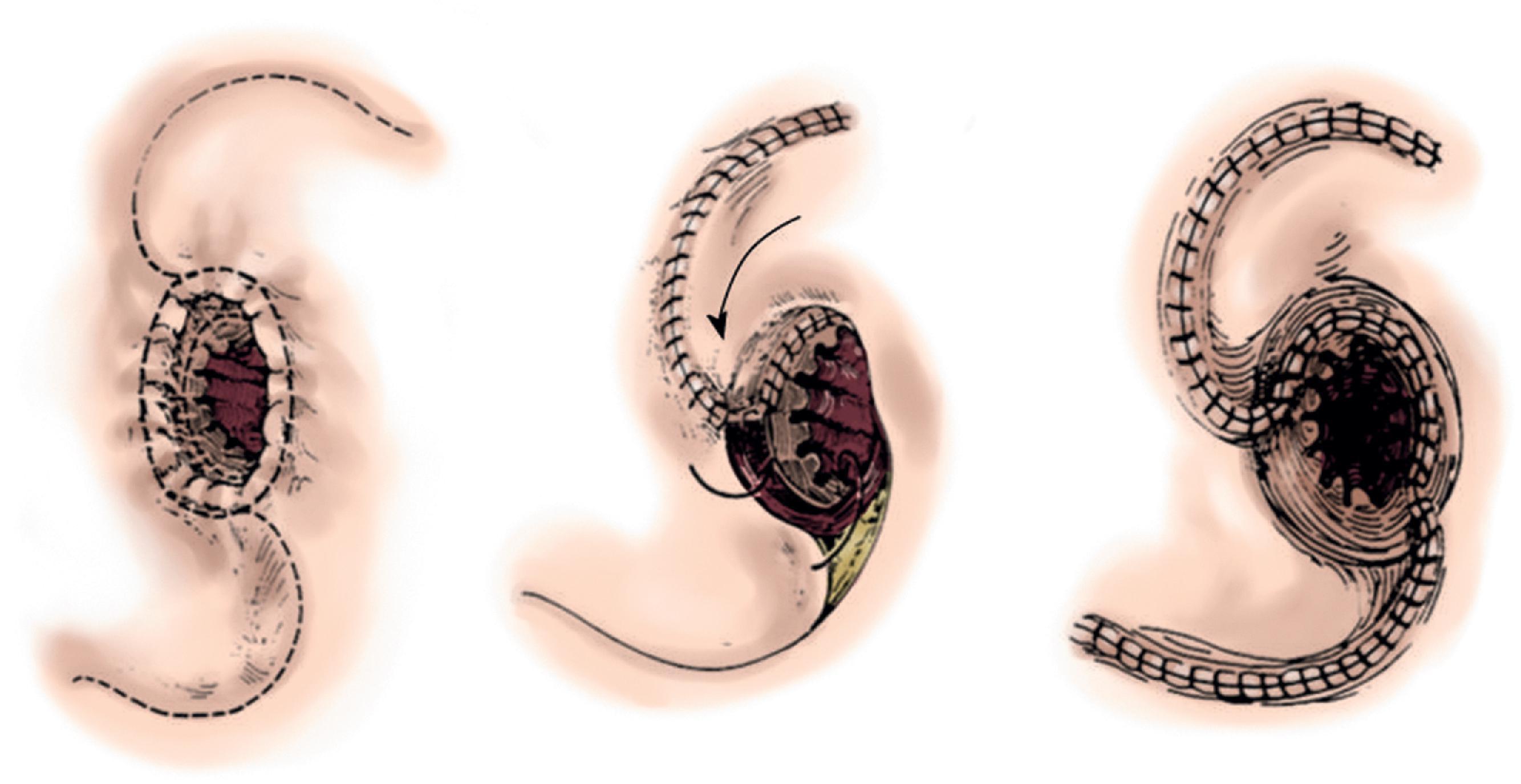
The majority of these procedures can be performed in an outpatient setting but may require admission depending on the extent of dissection or surgeon preference. Postoperative care typically involves adequate pain control, a strict bowel regimen that ensures soft stools, and sitz baths or showers to keep the wounds clean (Chiarelli et al., 2018). Complications include wound infection, flap ischemia, fecal incontinence, failure to correct stenosis, recurrent stenosis, and ectropion (Brisinda et al., 2009; Casadesus et al., 2007). Complication rates are relatively low, and good patient satisfaction has been demonstrated with diamond, Y-V, and house flaps (Farid et al., 2010).
Given the multitude of options, Duieb et al. described an algorithmic intraoperative approach to deciding which technique to use. First, an initial longitudinal incision through the stricture is created, assessing for a sphincter component, and sphincterotomy is performed when necessary. Next, primary transverse closure is attempted if there is no tension. If excessive tension is present, then a Y incision is created via extension of the initial longitudinal incision, and a Y-V flap is attempted. If there is continued tension, the Y incision is extended to create a diamond flap. Even though low complication rates were reported, this approach was only performed in a small subset of patients and by only one surgeon (Duieb et al., 2009). It does not consider the different patterns and extent of stenosis and is solely based on tension. Farid et al. reported on 60 patients with anal stenosis. They demonstrated that house flap reconstruction achieved greater anal caliber while maintaining continence and significantly improved quality of life when compared with Y-V and diamond-shaped flaps (Farid et al., 2010). In conclusion, there is no clear consensus on which technique is superior. Selection of approach is ultimately based on surgeon experience and should be individualized based on surgical history and anatomy, taking into consideration the benefits and limitations noted with each of the procedures.
Become a Clinical Tree membership for Full access and enjoy Unlimited articles
If you are a member. Log in here